|
PLearn 0.1
|
|
PLearn 0.1
|
Feedforward Neural Network for symbolic data represented using features. More...
#include <FeatureSetSequentialCRF.h>
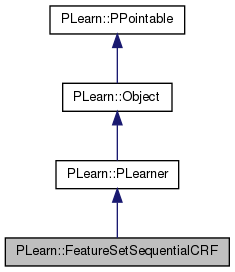
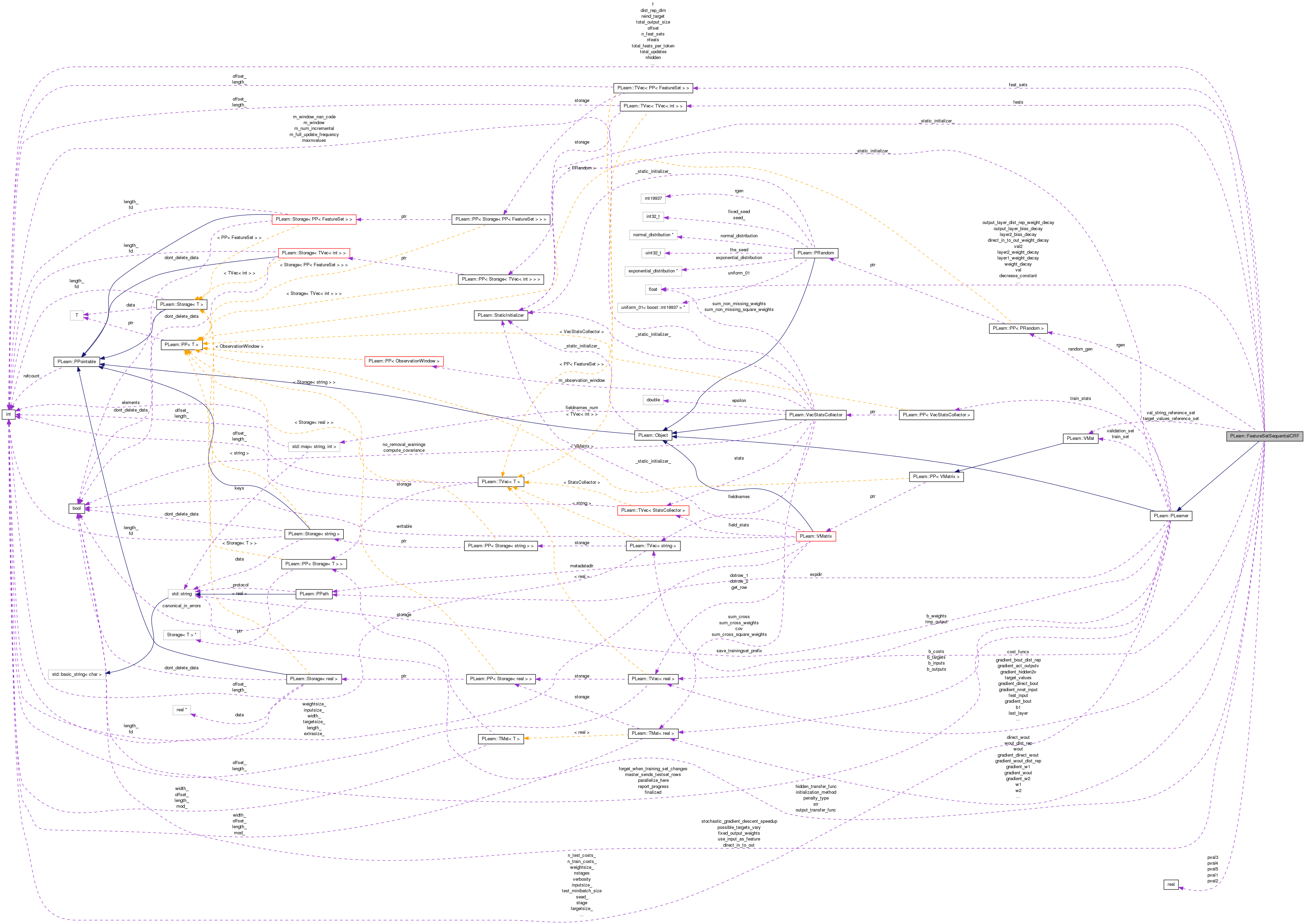
Public Member Functions | |
| FeatureSetSequentialCRF () | |
| virtual | ~FeatureSetSequentialCRF () |
| virtual string | classname () const |
| virtual OptionList & | getOptionList () const |
| virtual OptionMap & | getOptionMap () const |
| virtual RemoteMethodMap & | getRemoteMethodMap () const |
| virtual FeatureSetSequentialCRF * | deepCopy (CopiesMap &copies) const |
| virtual void | build () |
| Finish building the object; just call inherited::build followed by build_() | |
| virtual void | forget () |
| *** SUBCLASS WRITING: *** | |
| virtual int | outputsize () const |
| SUBCLASS WRITING: override this so that it returns the size of this learner's output, as a function of its inputsize(), targetsize() and set options. | |
| virtual TVec< string > | getTrainCostNames () const |
| *** SUBCLASS WRITING: *** | |
| virtual TVec< string > | getTestCostNames () const |
| *** SUBCLASS WRITING: *** | |
| virtual void | train () |
| *** SUBCLASS WRITING: *** | |
| virtual void | computeOutput (const Vec &input, Vec &output) const |
| *** SUBCLASS WRITING: *** | |
| virtual void | computeOutputAndCosts (const Vec &input, const Vec &target, Vec &output, Vec &costs) const |
| Default calls computeOutput and computeCostsFromOutputs. | |
| virtual void | computeCostsFromOutputs (const Vec &input, const Vec &output, const Vec &target, Vec &costs) const |
| *** SUBCLASS WRITING: *** | |
| virtual void | makeDeepCopyFromShallowCopy (CopiesMap &copies) |
| Transforms a shallow copy into a deep copy. | |
Static Public Member Functions | |
| static string | _classname_ () |
| static OptionList & | _getOptionList_ () |
| static RemoteMethodMap & | _getRemoteMethodMap_ () |
| static Object * | _new_instance_for_typemap_ () |
| static bool | _isa_ (const Object *o) |
| static void | _static_initialize_ () |
| static const PPath & | declaringFile () |
Public Attributes | |
| Mat | w1 |
| Weights of first hidden layer. | |
| Mat | gradient_w1 |
| Gradient on weights of first hidden layer. | |
| Vec | b1 |
| Bias of first hidden layer. | |
| Vec | gradient_b1 |
| Gradient on bias of first hidden layer. | |
| Mat | w2 |
| Weights of second hidden layer. | |
| Mat | gradient_w2 |
| gradient on weights of second hidden layer | |
| Vec | b2 |
| Bias of second hidden layer. | |
| Vec | gradient_b2 |
| Gradient on bias of second hidden layer. | |
| Mat | wout |
| Weights of output layer. | |
| Mat | gradient_wout |
| Gradient on weights of output layer. | |
| Vec | bout |
| Bias of output layer. | |
| Vec | gradient_bout |
| Gradient on bias of output layer. | |
| Mat | direct_wout |
| Direct input to output weights. | |
| Mat | gradient_direct_wout |
| Gradient on direct input to output weights. | |
| Vec | direct_bout |
| Direct input to output bias (empty, since no bias is used) | |
| Vec | gradient_direct_bout |
| Gradient on direct input to output bias (empty, since no bias is used) | |
| Mat | wout_dist_rep |
| Weights of output layer for distributed representation predictor. | |
| Mat | gradient_wout_dist_rep |
| Gradient on weights of output layer for distributed representation predictor. | |
| Vec | bout_dist_rep |
| Bias of output layer for distributed representation predictor. | |
| Vec | gradient_bout_dist_rep |
| Gradient on bias of output layer for distributed representation predictor. | |
| int | nhidden |
| Number of hidden nunits in first hidden layer (default:0) | |
| int | nhidden2 |
| Number of hidden units in second hidden layer (default:0) | |
| real | weight_decay |
| Weight decay (default:0) | |
| real | bias_decay |
| Bias decay (default:0) | |
| real | layer1_weight_decay |
| Weight decay for weights from input layer to first hidden layer (default:0) | |
| real | layer1_bias_decay |
| Bias decay for weights from input layer to first hidden layer (default:0) | |
| real | layer2_weight_decay |
| Weight decay for weights from first hidden layer to second hidden layer (default:0) | |
| real | layer2_bias_decay |
| Bias decay for weights from first hidden layer to second hidden layer (default:0) | |
| real | output_layer_weight_decay |
| Weight decay for weights from last hidden layer to output layer (default:0) | |
| real | output_layer_bias_decay |
| Bias decay for weights from last hidden layer to output layer (default:0) | |
| real | direct_in_to_out_weight_decay |
| Weight decay for weights from input directly to output layer (default:0) | |
| real | output_layer_dist_rep_weight_decay |
| Weight decay for weights from last hidden layer to output layer of distributed representation predictor (default:0) | |
| real | output_layer_dist_rep_bias_decay |
| Bias decay for weights from last hidden layer to output layer of distributed representation predictor (default:0) | |
| real | margin |
| Margin requirement, used only with the margin_perceptron_cost cost function (default:1) | |
| bool | fixed_output_weights |
| If true then the output weights are not learned. | |
| bool | direct_in_to_out |
| If true then direct input to output weights will be added (if nhidden > 0) | |
| string | penalty_type |
| Penalty to use on the weights (for weight and bias decay) (default:"L2_square") | |
| string | output_transfer_func |
| Transfer function to use for ouput layer (default:"") | |
| string | hidden_transfer_func |
| Transfer function to use for hidden units (default:"tanh") tanh, sigmoid, softplus, softmax, etc... | |
| TVec< string > | cost_funcs |
| Cost functions. | |
| real | start_learning_rate |
| Start learning rate of gradient descent. | |
| real | decrease_constant |
| Decrease constant of gradietn descent. | |
| int | batch_size |
| Number of samples to use to estimate gradient before an update. | |
| bool | stochastic_gradient_descent_speedup |
| Indication that a trick to speedup stochastic gradient descent should be used. | |
| string | initialization_method |
| Method of initialization for neural network's weights. | |
| int | dist_rep_dim |
| Dimensionality (number of components) of distributed representations If <= 0, than distributed representations will not be used. | |
| bool | possible_targets_vary |
| Indication that the set of possible targets vary from one input vector to another. | |
| TVec< PP< FeatureSet > > | feat_sets |
| FeatureSets to apply on input. | |
| bool | use_input_as_feature |
| Indication that the input IDs should be used as the feature ID. | |
Static Public Attributes | |
| static StaticInitializer | _static_initializer_ |
Protected Member Functions | |
| void | fprop (const Vec &inputv, Vec &outputv, const Vec &targetv, Vec &costsv, real sampleweight=1) const |
| Forward propagation in the network. | |
| void | fpropOutput (const Vec &inputv, Vec &outputv) const |
| Forward propagation to compute the output. | |
| void | fpropCostsFromOutput (const Vec &inputv, const Vec &outputv, const Vec &targetv, Vec &costsv, real sampleweight=1) const |
| Forward propagation to compute the costs from the output. | |
| void | bprop (Vec &inputv, Vec &outputv, Vec &targetv, Vec &costsv, real learning_rate, real sampleweight=1) |
| Backward propagation in the network, which assumes that a forward propagation has been done before. | |
| void | update () |
| Update network's parameters. | |
| void | update_affine_transform (Vec input, Mat weights, Vec bias, Mat gweights, Vec gbias, bool input_is_sparse, bool output_is_sparse, Vec output_indices) |
| Update affine transformation's parameters. | |
| void | clearProppathGradient () |
| Clear network's propagation path gradient fields Assumes fprop and bprop have been called before. | |
| virtual void | initializeParams (bool set_seed=true) |
| Initialize the parameters. | |
| void | add_transfer_func (const Vec &input, string transfer_func="default") const |
| Computes the result of the application of the given transfer function on the input vector. | |
| void | gradient_transfer_func (Vec &output, Vec &gradient_input, Vec &gradient_output, string transfer_func="default", int nll_softmax_speed_up_target=-1) |
| Computes the gradient through the given activation function, the output value and the initial gradient on that output (i.e. | |
| void | add_affine_transform (Vec input, Mat weights, Vec bias, Vec output, bool input_is_sparse, bool output_is_sparse, Vec output_indices=Vec(0)) const |
| Applies affine transform on input using provided weights and bias. | |
| void | gradient_affine_transform (Vec input, Mat weights, Vec bias, Vec ginput, Mat gweights, Vec gbias, Vec goutput, bool input_is_sparse, bool output_is_sparse, real learning_rate, real weight_decay, real bias_decay, Vec output_indices=Vec(0)) |
| Propagate gradient through affine transform on input using provided weights and bias. | |
| void | gradient_penalty (Vec input, Mat weights, Vec bias, Mat gweights, Vec gbias, bool input_is_sparse, bool output_is_sparse, real learning_rate, real weight_decay, real bias_decay, Vec output_indices=Vec(0)) |
| Propagate penalty gradient through weights and bias, scaled by -learning rate. | |
| void | fillWeights (const Mat &weights) |
| Fill a matrix of weights according to the 'initialization_method' specified. | |
| void | verify_gradient (Vec &input, Vec target, real step) |
| Verify gradient of propagation path. | |
| void | verify_gradient_affine_transform (Vec global_input, Vec &global_output, Vec &global_targetv, Vec &global_costs, real sampleweight, Vec input, Mat weights, Vec bias, Mat est_gweights, Vec est_gbias, bool input_is_sparse, bool output_is_sparse, real step, Vec output_indices=Vec(0)) const |
| Verify gradient of affine_transform parameters. | |
| void | output_gradient_verification (Vec grad, Vec est_grad) |
| void | batchComputeOutputAndConfidence (VMat inputs, real probability, VMat outputs_and_confidence) const |
| Changes the reference_set and then calls the parent's class method. | |
| virtual void | use (VMat testset, VMat outputs) const |
| Changes the reference_set and then calls the parent's class method. | |
| virtual void | test (VMat testset, PP< VecStatsCollector > test_stats, VMat testoutputs=0, VMat testcosts=0) const |
| Changes the reference_set and then calls the parent's class method. | |
| virtual VMat | processDataSet (VMat dataset) const |
| Changes the reference_set and then calls the parent's class method. | |
Static Protected Member Functions | |
| static void | declareOptions (OptionList &ol) |
| Declares this class' options. | |
Protected Attributes | |
| int | total_output_size |
| Total output size. | |
| int | total_updates |
| Total updates so far;. | |
| int | n_feat_sets |
| Number of feature sets. | |
| int | total_feats_per_token |
| Number of features per input token for which a distributed representation is computed. | |
| int | reind_target |
| Reindexed target. | |
| Vec | feat_input |
| Feature input;. | |
| Vec | gradient_feat_input |
| Gradient on feature input (useless for now) | |
| Vec | nnet_input |
| Input vector to NNet (after mapping into distributed representations) | |
| Vec | gradient_nnet_input |
| Gradient for vector to NNet. | |
| Vec | hiddenv |
| First hidden layer value. | |
| Vec | gradient_hiddenv |
| Gradient of first hidden layer. | |
| Vec | gradient_act_hiddenv |
| Gradient through first hidden layer activation. | |
| Vec | hidden2v |
| Second hidden layer value. | |
| Vec | gradient_hidden2v |
| Gradient of second hidden layer. | |
| Vec | gradient_act_hidden2v |
| Gradient through second hidden layer activation. | |
| Vec | gradient_outputv |
| Gradient on output. | |
| Vec | gradient_act_outputv |
| Gradient throught output layer activation. | |
| PP< PRandom > | rgen |
| Random number generator for parameters initialization. | |
| Vec | feats_since_last_update |
| Features seen in input since last update. | |
| Vec | target_values_since_last_update |
| Possible target values seen since last update. | |
| VMat | val_string_reference_set |
| VMatrix used to get values to string mapping for input tokens. | |
| VMat | target_values_reference_set |
| Possible target values mapping. | |
Private Types | |
| typedef PLearner | inherited |
Private Member Functions | |
| void | build_ () |
| **** SUBCLASS WRITING: **** | |
| void | compute_softmax (const Vec &x, const Vec &y) const |
| Softmax vector y obtained on x This implementation is such that compute_softmax(x,x) is such that x becomes its softmax value. | |
| real | nll (const Vec &outputv, int target) const |
| Negative log-likelihood loss. | |
| real | classification_loss (const Vec &outputv, int target) const |
| Classification loss. | |
| int | my_argmax (const Vec &vec, int default_compare=0) const |
| Argmax function that lets you define the default (first) component used for comparisons. | |
Private Attributes | |
| Vec | target_values |
| Vector of possible target values. | |
| Vec | output_comp |
| Vector for output computations. | |
| Vec | row |
| Row vector. | |
| Vec | last_layer |
| Last layer of network (pointer to either nnet_input, vnhidden or vnhidden2) | |
| Vec | gradient_last_layer |
| Gradient of last layer in back propagation. | |
| TVec< TVec< int > > | feats |
| Features for each token. | |
| Vec | gradient |
| Temporary computations variable, used in fprop() and bprop() Care must be taken when using these variables, since they are used by many different functions. | |
| string | str |
| real * | pval1 |
| real * | pval2 |
| real * | pval3 |
| real * | pval4 |
| real * | pval5 |
| real | val |
| real | val2 |
| real | grad |
| int | offset |
| int | ni |
| int | nj |
| int | nk |
| int | id |
| int | nfeats |
| int | ifeats |
| int * | f |
Feedforward Neural Network for symbolic data represented using features.
Inspired from the NNet class, FeatureSetSequentialCRF is simply an extension that deals with feature representations of symbolic data. It can also learn distributed representations for each symbolic input token. The possible targets are defined by the VMatrix's getValues() function.
Definition at line 55 of file FeatureSetSequentialCRF.h.
typedef PLearner PLearn::FeatureSetSequentialCRF::inherited [private] |
Reimplemented from PLearn::PLearner.
Definition at line 60 of file FeatureSetSequentialCRF.h.
| PLearn::FeatureSetSequentialCRF::FeatureSetSequentialCRF | ( | ) |
Definition at line 53 of file FeatureSetSequentialCRF.cc.
: rgen(new PRandom()), nhidden(0), nhidden2(0), weight_decay(0), bias_decay(0), layer1_weight_decay(0), layer1_bias_decay(0), layer2_weight_decay(0), layer2_bias_decay(0), output_layer_weight_decay(0), output_layer_bias_decay(0), direct_in_to_out_weight_decay(0), output_layer_dist_rep_weight_decay(0), output_layer_dist_rep_bias_decay(0), fixed_output_weights(0), direct_in_to_out(0), penalty_type("L2_square"), output_transfer_func(""), hidden_transfer_func("tanh"), start_learning_rate(0.01), decrease_constant(0), batch_size(1), stochastic_gradient_descent_speedup(true), initialization_method("uniform_linear"), dist_rep_dim(-1), possible_targets_vary(false) {}
| PLearn::FeatureSetSequentialCRF::~FeatureSetSequentialCRF | ( | ) | [virtual] |
Definition at line 83 of file FeatureSetSequentialCRF.cc.
{
}
| string PLearn::FeatureSetSequentialCRF::_classname_ | ( | ) | [static] |
Reimplemented from PLearn::PLearner.
Definition at line 51 of file FeatureSetSequentialCRF.cc.
| OptionList & PLearn::FeatureSetSequentialCRF::_getOptionList_ | ( | ) | [static] |
Reimplemented from PLearn::PLearner.
Definition at line 51 of file FeatureSetSequentialCRF.cc.
| RemoteMethodMap & PLearn::FeatureSetSequentialCRF::_getRemoteMethodMap_ | ( | ) | [static] |
Reimplemented from PLearn::PLearner.
Definition at line 51 of file FeatureSetSequentialCRF.cc.
Reimplemented from PLearn::PLearner.
Definition at line 51 of file FeatureSetSequentialCRF.cc.
| Object * PLearn::FeatureSetSequentialCRF::_new_instance_for_typemap_ | ( | ) | [static] |
Reimplemented from PLearn::Object.
Definition at line 51 of file FeatureSetSequentialCRF.cc.
| StaticInitializer FeatureSetSequentialCRF::_static_initializer_ & PLearn::FeatureSetSequentialCRF::_static_initialize_ | ( | ) | [static] |
Reimplemented from PLearn::PLearner.
Definition at line 51 of file FeatureSetSequentialCRF.cc.
| void PLearn::FeatureSetSequentialCRF::add_affine_transform | ( | Vec | input, |
| Mat | weights, | ||
| Vec | bias, | ||
| Vec | output, | ||
| bool | input_is_sparse, | ||
| bool | output_is_sparse, | ||
| Vec | output_indices = Vec(0) |
||
| ) | const [protected] |
Applies affine transform on input using provided weights and bias.
Information about the nature of the input and output need to be provided. If bias.length() == 0, then output initial value is used as the bias.
Definition at line 1030 of file FeatureSetSequentialCRF.cc.
References PLearn::TVec< T >::data(), i, j, PLearn::TVec< T >::length(), ni, nj, pval1, pval2, pval3, and PLearn::transposeProductAcc().
Referenced by fpropOutput().
{
// Bias
if(bias.length() != 0)
{
if(output_is_sparse)
{
pval1 = output.data();
pval2 = bias.data();
pval3 = output_indices.data();
ni = output.length();
for(int i=0; i<ni; i++)
*pval1++ = pval2[(int)*pval3++];
}
else
{
pval1 = output.data();
pval2 = bias.data();
ni = output.length();
for(int i=0; i<ni; i++)
*pval1++ = *pval2++;
}
}
// Weights
if(!input_is_sparse && !output_is_sparse)
{
transposeProductAcc(output,weights,input);
}
else if(!input_is_sparse && output_is_sparse)
{
ni = output.length();
nj = input.length();
pval1 = output.data();
pval3 = output_indices.data();
for(int i=0; i<ni; i++)
{
pval2 = input.data();
for(int j=0; j<nj; j++)
*pval1 += (*pval2++)*weights(j,(int)*pval3);
pval1++;
pval3++;
}
}
else if(input_is_sparse && !output_is_sparse)
{
ni = input.length();
nj = output.length();
if(ni != 0)
{
pval3 = input.data();
for(int i=0; i<ni; i++)
{
pval1 = output.data();
pval2 = weights[(int)(*pval3++)];
for(int j=0; j<nj;j++)
*pval1++ += *pval2++;
}
}
}
else if(input_is_sparse && output_is_sparse)
{
// Weights
ni = input.length();
nj = output.length();
if(ni != 0)
{
pval2 = input.data();
for(int i=0; i<ni; i++)
{
pval1 = output.data();
pval3 = output_indices.data();
for(int j=0; j<nj; j++)
*pval1++ += weights((int)(*pval2),(int)*pval3++);
pval2++;
}
}
}
}
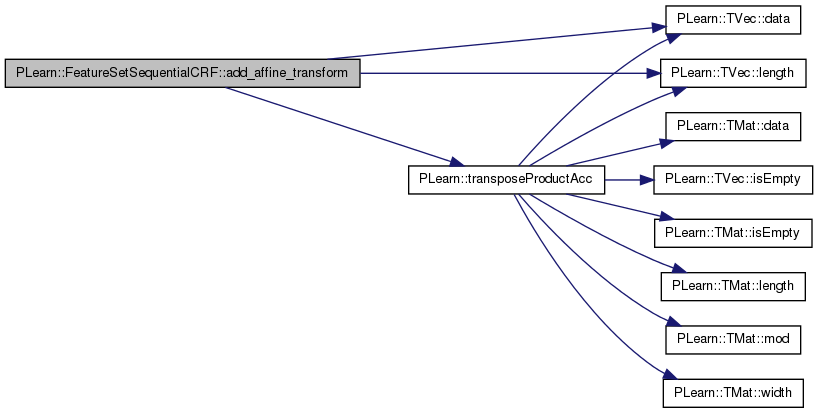

| void PLearn::FeatureSetSequentialCRF::add_transfer_func | ( | const Vec & | input, |
| string | transfer_func = "default" |
||
| ) | const [protected] |
Computes the result of the application of the given transfer function on the input vector.
Definition at line 921 of file FeatureSetSequentialCRF.cc.
References PLearn::compute_sigmoid(), compute_softmax(), PLearn::compute_tanh(), hidden_transfer_func, and PLERROR.
Referenced by fpropOutput().
{
if (transfer_func == "default")
transfer_func = hidden_transfer_func;
if(transfer_func=="linear")
return;
else if(transfer_func=="tanh")
{
compute_tanh(input,input);
return;
}
else if(transfer_func=="sigmoid")
{
compute_sigmoid(input,input);
return;
}
else if(transfer_func=="softmax")
{
compute_softmax(input,input);
return;
}
else PLERROR("In FeatureSetSequentialCRF::add_transfer_func(): Unknown value for transfer_func: %s",transfer_func.c_str());
}
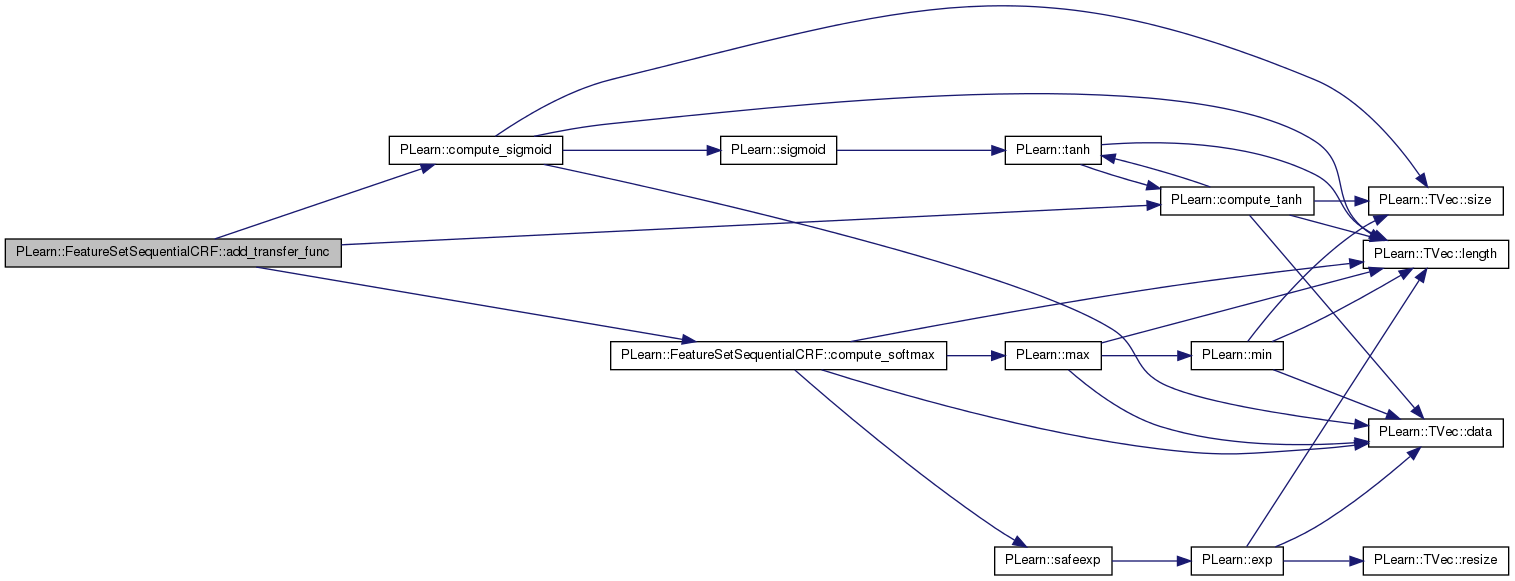

| void PLearn::FeatureSetSequentialCRF::batchComputeOutputAndConfidence | ( | VMat | inputs, |
| real | probability, | ||
| VMat | outputs_and_confidence | ||
| ) | const [protected, virtual] |
Changes the reference_set and then calls the parent's class method.
Reimplemented from PLearn::PLearner.
Definition at line 2544 of file FeatureSetSequentialCRF.cc.
References PLearn::PLearner::batchComputeOutputAndConfidence(), PLearn::PLearner::train_set, and val_string_reference_set.
{
val_string_reference_set = inputs;
inherited::batchComputeOutputAndConfidence(inputs,probability,outputs_and_confidence);
val_string_reference_set = train_set;
}

| void PLearn::FeatureSetSequentialCRF::bprop | ( | Vec & | inputv, |
| Vec & | outputv, | ||
| Vec & | targetv, | ||
| Vec & | costsv, | ||
| real | learning_rate, | ||
| real | sampleweight = 1 |
||
| ) | [protected] |
Backward propagation in the network, which assumes that a forward propagation has been done before.
A learning rate needs to be provided because it is -learning_rate * gradient that is propagated, not just the gradient.
Definition at line 501 of file FeatureSetSequentialCRF.cc.
References PLearn::TVec< T >::append(), b1, b2, bias_decay, bout, bout_dist_rep, clearProppathGradient(), cost_funcs, direct_bout, direct_in_to_out, direct_in_to_out_weight_decay, direct_wout, dist_rep_dim, feat_input, feats, feats_since_last_update, gradient_act_hidden2v, gradient_act_hiddenv, gradient_act_outputv, gradient_affine_transform(), gradient_b1, gradient_b2, gradient_bout, gradient_bout_dist_rep, gradient_direct_bout, gradient_direct_wout, gradient_feat_input, gradient_hidden2v, gradient_hiddenv, gradient_last_layer, gradient_nnet_input, gradient_outputv, gradient_transfer_func(), gradient_w1, gradient_w2, gradient_wout, gradient_wout_dist_rep, hidden2v, hiddenv, i, ifeats, PLearn::PLearner::inputsize_, j, layer1_bias_decay, layer1_weight_decay, layer2_bias_decay, layer2_weight_decay, PLearn::TVec< T >::length(), n_feat_sets, nfeats, nhidden, nhidden2, nnet_input, output_layer_bias_decay, output_layer_dist_rep_bias_decay, output_layer_dist_rep_weight_decay, output_layer_weight_decay, output_transfer_func, PLERROR, possible_targets_vary, reind_target, PLearn::TVec< T >::resize(), stochastic_gradient_descent_speedup, PLearn::TVec< T >::subVec(), target_values, target_values_since_last_update, w1, w2, weight_decay, wout, and wout_dist_rep.
Referenced by verify_gradient().
{
if(possible_targets_vary)
{
gradient_outputv.resize(target_values.length());
gradient_act_outputv.resize(target_values.length());
if(!stochastic_gradient_descent_speedup)
target_values_since_last_update.append(target_values);
}
if(!stochastic_gradient_descent_speedup)
feats_since_last_update.append(feat_input);
// Gradient through cost
if(cost_funcs[0]=="NLL")
{
// Permits to avoid numerical precision errors
if(output_transfer_func == "softmax")
gradient_outputv[reind_target] = learning_rate*sampleweight;
else
gradient_outputv[reind_target] = learning_rate*sampleweight/(outputv[reind_target]);
}
else if(cost_funcs[0]=="class_error")
{
PLERROR("FeatureSetSequentialCRF::bprop(): gradient cannot be computed for \"class_error\" cost");
}
// Gradient through output transfer function
if(output_transfer_func != "linear")
{
if(cost_funcs[0]=="NLL" && output_transfer_func == "softmax")
gradient_transfer_func(outputv,gradient_act_outputv, gradient_outputv,
output_transfer_func, reind_target);
else
gradient_transfer_func(outputv,gradient_act_outputv, gradient_outputv,
output_transfer_func);
gradient_last_layer = gradient_act_outputv;
}
else
gradient_last_layer = gradient_act_outputv;
// Gradient through output affine transform
if(nhidden2 > 0) {
gradient_affine_transform(hidden2v, wout, bout, gradient_hidden2v,
gradient_wout, gradient_bout, gradient_last_layer,
false, possible_targets_vary, learning_rate,
weight_decay+output_layer_weight_decay,
bias_decay+output_layer_bias_decay,
target_values);
}
else if(nhidden > 0)
{
gradient_affine_transform(hiddenv, wout, bout, gradient_hiddenv,
gradient_wout, gradient_bout, gradient_last_layer,
false, possible_targets_vary, learning_rate,
weight_decay+output_layer_weight_decay,
bias_decay+output_layer_bias_decay, target_values);
}
else
{
gradient_affine_transform(nnet_input, wout, bout, gradient_nnet_input,
gradient_wout, gradient_bout, gradient_last_layer,
(dist_rep_dim <= 0), possible_targets_vary, learning_rate,
weight_decay+output_layer_weight_decay,
bias_decay+output_layer_bias_decay, target_values);
}
if(nhidden2 > 0)
{
gradient_transfer_func(hidden2v,gradient_act_hidden2v,gradient_hidden2v);
gradient_affine_transform(hiddenv, w2, b2, gradient_hiddenv,
gradient_w2, gradient_b2, gradient_act_hidden2v,
false, false,learning_rate,
weight_decay+layer2_weight_decay,
bias_decay+layer2_bias_decay);
}
if(nhidden > 0)
{
gradient_transfer_func(hiddenv,gradient_act_hiddenv,gradient_hiddenv);
gradient_affine_transform(nnet_input, w1, b1, gradient_nnet_input,
gradient_w1, gradient_b1, gradient_act_hiddenv,
dist_rep_dim<=0, false,learning_rate,
weight_decay+layer1_weight_decay,
bias_decay+layer1_bias_decay);
}
if(nhidden>0 && direct_in_to_out)
{
gradient_affine_transform(nnet_input, direct_wout, direct_bout,
gradient_nnet_input,
gradient_direct_wout, gradient_direct_bout,
gradient_last_layer,
dist_rep_dim<=0, possible_targets_vary,learning_rate,
weight_decay+direct_in_to_out_weight_decay,
0,
target_values);
}
if(dist_rep_dim > 0)
{
nfeats = 0;
id = 0;
for(int i=0; i<inputsize_; )
{
ifeats = 0;
for(int j=0; j<n_feat_sets; j++,i++)
ifeats += feats[i].length();
gradient_affine_transform(feat_input.subVec(nfeats,ifeats),
wout_dist_rep, bout_dist_rep,
//gradient_feat_input.subVec(nfeats,feats[i].length()),
gradient_feat_input,// Useless anyways...
gradient_wout_dist_rep,
gradient_bout_dist_rep,
gradient_nnet_input.subVec(id*dist_rep_dim,dist_rep_dim),
true, false, learning_rate,
weight_decay+output_layer_dist_rep_weight_decay,
bias_decay+output_layer_dist_rep_bias_decay);
nfeats += ifeats;
id++;
}
}
clearProppathGradient();
}
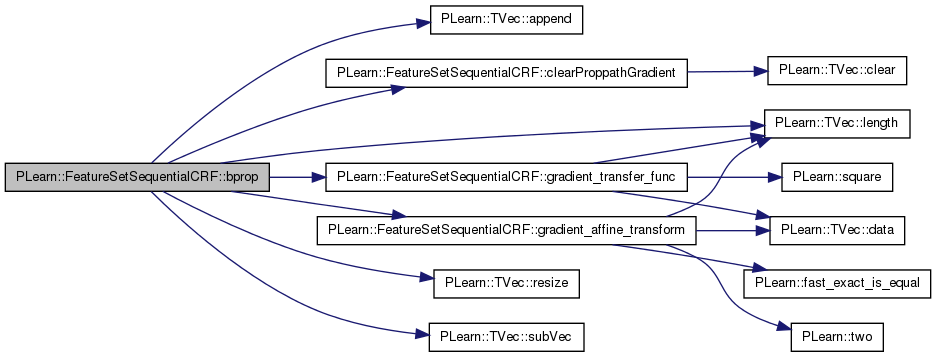

| void PLearn::FeatureSetSequentialCRF::build | ( | ) | [virtual] |
Finish building the object; just call inherited::build followed by build_()
Reimplemented from PLearn::PLearner.
Definition at line 277 of file FeatureSetSequentialCRF.cc.
References PLearn::PLearner::build(), and build_().
Referenced by forget().
{
inherited::build();
build_();
}
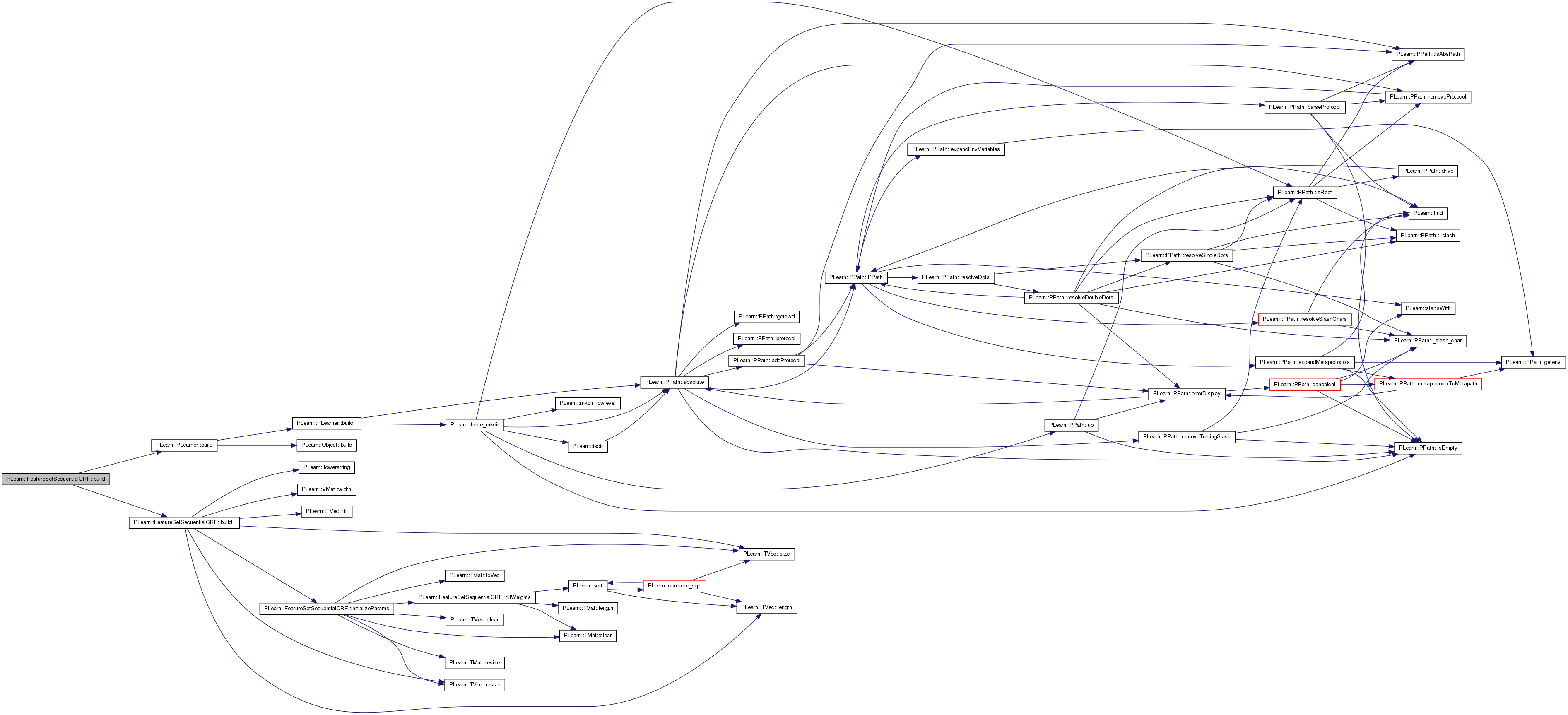

| void PLearn::FeatureSetSequentialCRF::build_ | ( | ) | [private] |
**** SUBCLASS WRITING: ****
This method should finish building of the object, according to set 'options', in *any* situation.
Typical situations include:
You can assume that the parent class' build_() has already been called.
A typical build method will want to know the inputsize(), targetsize() and outputsize(), and may also want to check whether train_set->hasWeights(). All these methods require a train_set to be set, so the first thing you may want to do, is check if(train_set), before doing any heavy building...
Note: build() is always called by setTrainingSet.
Reimplemented from PLearn::PLearner.
Definition at line 287 of file FeatureSetSequentialCRF.cc.
References cost_funcs, feat_sets, feats, PLearn::TVec< T >::fill(), fixed_output_weights, i, initializeParams(), PLearn::PLearner::inputsize_, PLearn::TVec< T >::length(), PLearn::lowerstring(), MISSING_VALUE, n_feat_sets, output_comp, penalty_type, PLERROR, PLWARNING, PLearn::TVec< T >::resize(), row, PLearn::TVec< T >::size(), PLearn::PLearner::stage, stochastic_gradient_descent_speedup, target_values_reference_set, PLearn::PLearner::targetsize_, total_output_size, PLearn::PLearner::train_set, val_string_reference_set, PLearn::PLearner::weightsize_, and PLearn::VMat::width().
Referenced by build().
{
// Don't do anything if we don't have a train_set
// It's the only one who knows the inputsize, targetsize and weightsize
if(inputsize_>=0 && targetsize_>=0 && weightsize_>=0)
{
if(targetsize_ != 1)
PLERROR("In FeatureSetSequentialCRF::build_(): targetsize_ must be 1, not %d",targetsize_);
n_feat_sets = feat_sets.length();
if(n_feat_sets == 0)
PLERROR("In FeatureSetSequentialCRF::build_(): at least one FeatureSet must be provided\n");
if(inputsize_ % n_feat_sets != 0)
PLERROR("In FeatureSetSequentialCRF::build_(): feat_sets.length() must be a divisor of inputsize()");
// Process penalty type option
string pt = lowerstring( penalty_type );
if( pt == "l1" )
penalty_type = "L1";
else if( pt == "l2_square" || pt == "l2 square" || pt == "l2square" )
penalty_type = "L2_square";
else if( pt == "l2" )
{
PLWARNING("In FeatureSetSequentialCRF::build_(): L2 penalty not supported, assuming you want L2 square");
penalty_type = "L2_square";
}
else
PLERROR("In FeatureSetSequentialCRF::build_(): penalty_type \"%s\" not supported", penalty_type.c_str());
int ncosts = cost_funcs.size();
if(ncosts<=0)
PLERROR("In FeatureSetSequentialCRF::build_(): Empty cost_funcs : must at least specify the cost function to optimize!");
if(stage <= 0 ) // Training hasn't started
{
// Initialize parameters
initializeParams();
}
output_comp.resize(total_output_size);
row.resize(train_set->width());
row.fill(MISSING_VALUE);
feats.resize(inputsize_);
// Making sure that all feats[i] have non null storage...
for(int i=0; i<feats.length(); i++)
{
feats[i].resize(1);
feats[i].resize(0);
}
if(fixed_output_weights && stochastic_gradient_descent_speedup)
PLERROR("In FeatureSetSequentialCRF::build_(): cannot use stochastic gradient descent speedup with fixed output weights");
val_string_reference_set = train_set;
target_values_reference_set = train_set;
}
}
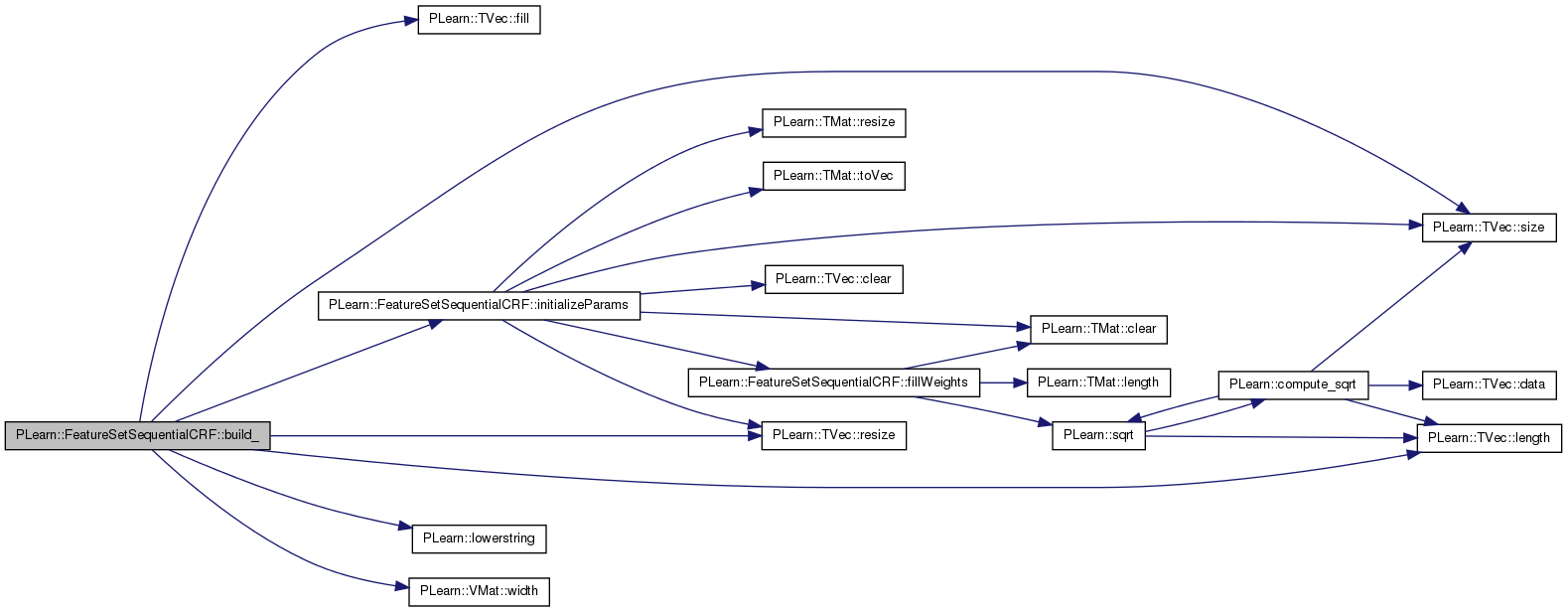

| real PLearn::FeatureSetSequentialCRF::classification_loss | ( | const Vec & | outputv, |
| int | target | ||
| ) | const [private] |
Classification loss.
Definition at line 1761 of file FeatureSetSequentialCRF.cc.
References PLearn::argmax().
Referenced by fpropCostsFromOutput().
{
return (argmax(outputv) == target ? 0 : 1);
}


| string PLearn::FeatureSetSequentialCRF::classname | ( | ) | const [virtual] |
Reimplemented from PLearn::Object.
Definition at line 51 of file FeatureSetSequentialCRF.cc.
| void PLearn::FeatureSetSequentialCRF::clearProppathGradient | ( | ) | [protected] |
Clear network's propagation path gradient fields Assumes fprop and bprop have been called before.
Clear network's gradient fields.
Definition at line 787 of file FeatureSetSequentialCRF.cc.
References PLearn::TVec< T >::clear(), cost_funcs, dist_rep_dim, gradient_act_hidden2v, gradient_act_hiddenv, gradient_act_outputv, gradient_hidden2v, gradient_hiddenv, gradient_nnet_input, gradient_outputv, nhidden, nhidden2, and reind_target.
Referenced by bprop(), and verify_gradient().
{
// Trick to make clearProppathGradient faster...
if(cost_funcs[0]=="NLL")
gradient_outputv[reind_target] = 0;
else
gradient_outputv.clear();
gradient_act_outputv.clear();
if(dist_rep_dim>0)
gradient_nnet_input.clear();
if(nhidden>0)
{
gradient_hiddenv.clear();
gradient_act_hiddenv.clear();
if(nhidden2>0)
{
gradient_hidden2v.clear();
gradient_act_hidden2v.clear();
}
}
}


| void PLearn::FeatureSetSequentialCRF::compute_softmax | ( | const Vec & | x, |
| const Vec & | y | ||
| ) | const [private] |
Softmax vector y obtained on x This implementation is such that compute_softmax(x,x) is such that x becomes its softmax value.
Definition at line 1728 of file FeatureSetSequentialCRF.cc.
References PLearn::TVec< T >::data(), i, PLearn::TVec< T >::length(), PLearn::max(), n, PLERROR, and PLearn::safeexp().
Referenced by add_transfer_func().
{
int n = x.length();
// real* yp = y.data();
// real* xp = x.data();
// for(int i=0; i<n; i++)
// {
// *yp++ = *xp > 1e-5 ? *xp : 1e-5;
// xp++;
// }
if (n>0)
{
real* yp = y.data();
real* xp = x.data();
real maxx = max(x);
real s = 0;
for (int i=0;i<n;i++)
s += (*yp++ = safeexp(*xp++-maxx));
if (s == 0) PLERROR("trying to divide by 0 in softmax");
s = 1.0 / s;
yp = y.data();
for (int i=0;i<n;i++)
*yp++ *= s;
}
}


| void PLearn::FeatureSetSequentialCRF::computeCostsFromOutputs | ( | const Vec & | input, |
| const Vec & | output, | ||
| const Vec & | target, | ||
| Vec & | costs | ||
| ) | const [virtual] |
*** SUBCLASS WRITING: ***
This should be defined in subclasses to compute the weighted costs from already computed output. The costs should correspond to the cost names returned by getTestCostNames().
NOTE: In exotic cases, the cost may also depend on some info in the input, that's why the method also gets so see it.
Implements PLearn::PLearner.
Definition at line 815 of file FeatureSetSequentialCRF.cc.
References PLERROR.
{
PLERROR("In FeatureSetSequentialCRF::computeCostsFromOutputs(): output is not enough to compute costs");
}
| void PLearn::FeatureSetSequentialCRF::computeOutput | ( | const Vec & | input, |
| Vec & | output | ||
| ) | const [virtual] |
*** SUBCLASS WRITING: ***
This should be defined in subclasses to compute the output from the input.
Reimplemented from PLearn::PLearner.
Definition at line 842 of file FeatureSetSequentialCRF.cc.
References PLearn::argmax(), fpropOutput(), PLearn::TVec< T >::length(), my_argmax(), output_comp, possible_targets_vary, rgen, and target_values.
{
fpropOutput(inputv, output_comp);
if(possible_targets_vary)
{
//row.subVec(0,inputsize_) << inputv;
//target_values_reference_set->getValues(row,inputsize_,target_values);
outputv[0] = target_values[my_argmax(output_comp,rgen->uniform_multinomial_sample(output_comp.length()))];
}
else
outputv[0] = argmax(output_comp);
}
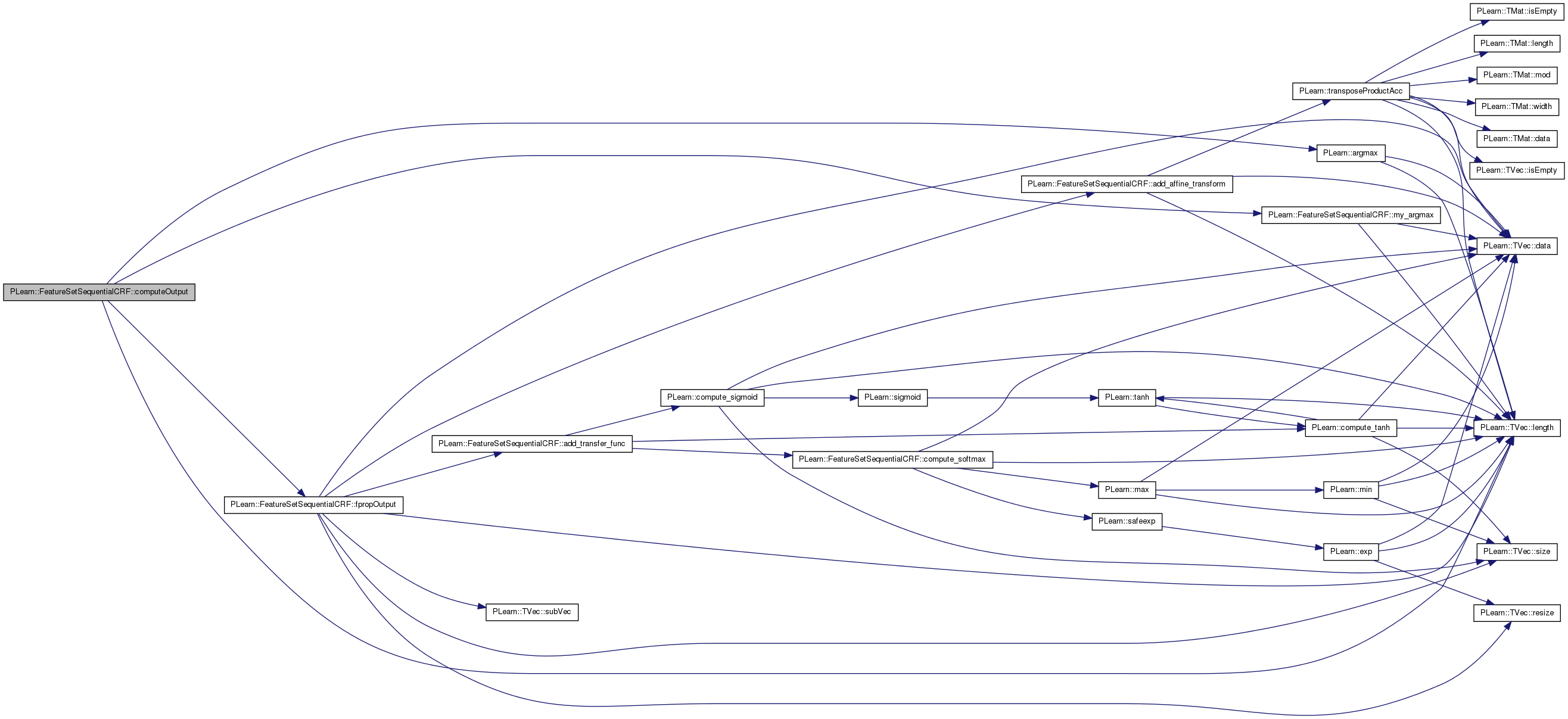
| void PLearn::FeatureSetSequentialCRF::computeOutputAndCosts | ( | const Vec & | input, |
| const Vec & | target, | ||
| Vec & | output, | ||
| Vec & | costs | ||
| ) | const [virtual] |
Default calls computeOutput and computeCostsFromOutputs.
You may override this if you have a more efficient way to compute both output and weighted costs at the same time.
Reimplemented from PLearn::PLearner.
Definition at line 858 of file FeatureSetSequentialCRF.cc.
References PLearn::argmax(), fprop(), PLearn::TVec< T >::length(), my_argmax(), output_comp, possible_targets_vary, rgen, and target_values.
{
fprop(inputv,output_comp,targetv,costsv);
if(possible_targets_vary)
{
//row.subVec(0,inputsize_) << inputv;
//target_values_reference_set->getValues(row,inputsize_,target_values);
outputv[0] = target_values[my_argmax(output_comp,rgen->uniform_multinomial_sample(output_comp.length()))];
}
else
outputv[0] = argmax(output_comp);
}
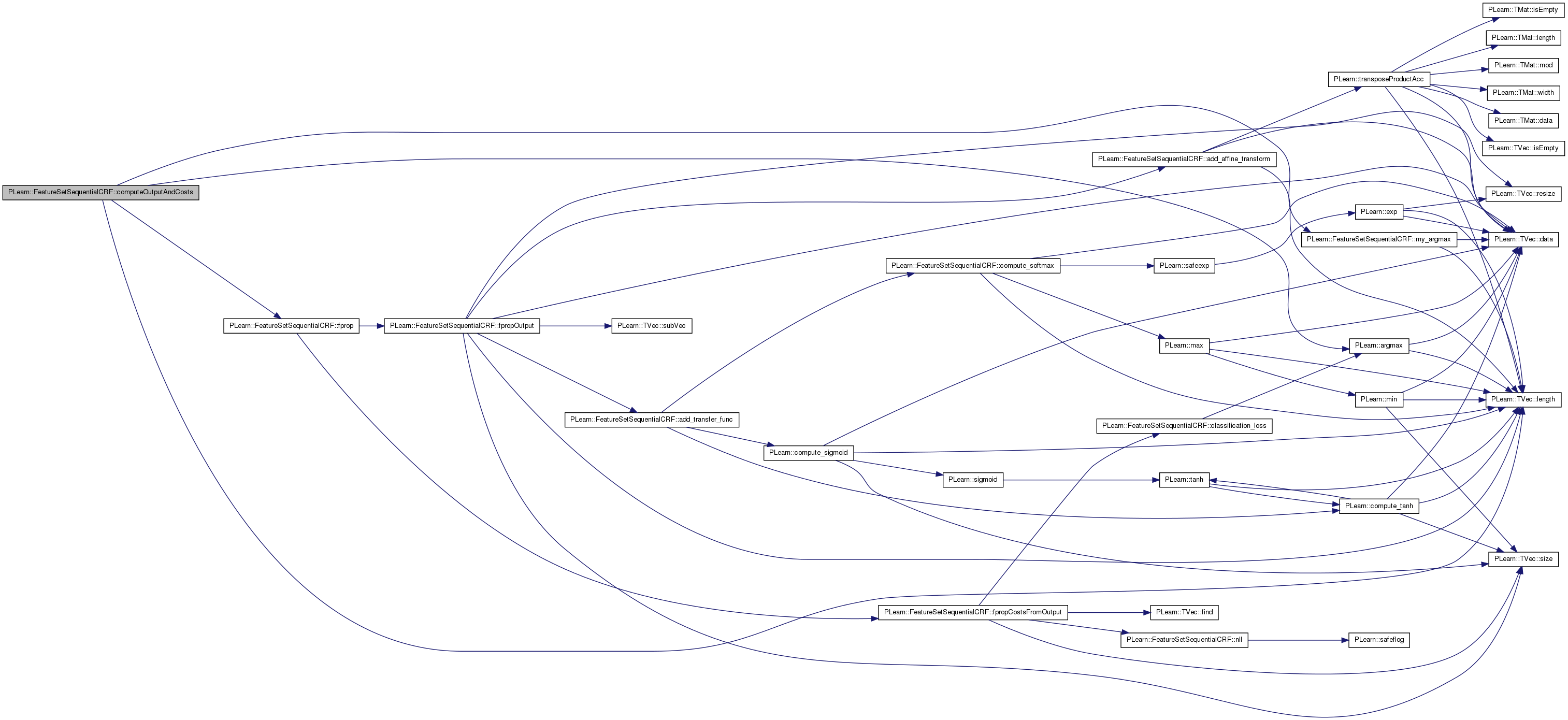
| void PLearn::FeatureSetSequentialCRF::declareOptions | ( | OptionList & | ol | ) | [static, protected] |
Declares this class' options.
Reimplemented from PLearn::PLearner.
Definition at line 87 of file FeatureSetSequentialCRF.cc.
References b1, b2, batch_size, bias_decay, bout, bout_dist_rep, PLearn::OptionBase::buildoption, cost_funcs, PLearn::declareOption(), PLearn::PLearner::declareOptions(), decrease_constant, direct_bout, direct_in_to_out, direct_in_to_out_weight_decay, direct_wout, dist_rep_dim, feat_sets, fixed_output_weights, hidden_transfer_func, initialization_method, layer1_bias_decay, layer1_weight_decay, layer2_bias_decay, layer2_weight_decay, PLearn::OptionBase::learntoption, nhidden, nhidden2, output_layer_bias_decay, output_layer_dist_rep_bias_decay, output_layer_dist_rep_weight_decay, output_layer_weight_decay, output_transfer_func, penalty_type, possible_targets_vary, start_learning_rate, stochastic_gradient_descent_speedup, PLearn::PLearner::train_set, w1, w2, weight_decay, wout, and wout_dist_rep.
{
declareOption(ol, "nhidden", &FeatureSetSequentialCRF::nhidden,
OptionBase::buildoption,
"Number of hidden units in first hidden layer (0 means no hidden layer).\n");
declareOption(ol, "nhidden2", &FeatureSetSequentialCRF::nhidden2,
OptionBase::buildoption,
"Number of hidden units in second hidden layer (0 means no hidden layer).\n");
declareOption(ol, "weight_decay", &FeatureSetSequentialCRF::weight_decay,
OptionBase::buildoption,
"Global weight decay for all layers.\n");
declareOption(ol, "bias_decay", &FeatureSetSequentialCRF::bias_decay,
OptionBase::buildoption,
"Global bias decay for all layers.\n");
declareOption(ol, "layer1_weight_decay", &FeatureSetSequentialCRF::layer1_weight_decay,
OptionBase::buildoption,
"Additional weight decay for the first hidden layer. Is added to weight_decay.\n");
declareOption(ol, "layer1_bias_decay", &FeatureSetSequentialCRF::layer1_bias_decay,
OptionBase::buildoption,
"Additional bias decay for the first hidden layer. Is added to bias_decay.\n");
declareOption(ol, "layer2_weight_decay", &FeatureSetSequentialCRF::layer2_weight_decay,
OptionBase::buildoption,
"Additional weight decay for the second hidden layer. Is added to weight_decay.\n");
declareOption(ol, "layer2_bias_decay", &FeatureSetSequentialCRF::layer2_bias_decay,
OptionBase::buildoption,
"Additional bias decay for the second hidden layer. Is added to bias_decay.\n");
declareOption(ol, "output_layer_weight_decay",
&FeatureSetSequentialCRF::output_layer_weight_decay,
OptionBase::buildoption,
"Additional weight decay for the output layer. Is added to 'weight_decay'.\n");
declareOption(ol, "output_layer_bias_decay",
&FeatureSetSequentialCRF::output_layer_bias_decay,
OptionBase::buildoption,
"Additional bias decay for the output layer. Is added to 'bias_decay'.\n");
declareOption(ol, "direct_in_to_out_weight_decay",
&FeatureSetSequentialCRF::direct_in_to_out_weight_decay,
OptionBase::buildoption,
"Additional weight decay for the weights going from the input directly to the output layer. Is added to 'weight_decay'.\n");
declareOption(ol, "output_layer_dist_rep_weight_decay",
&FeatureSetSequentialCRF::output_layer_dist_rep_weight_decay,
OptionBase::buildoption,
"Additional weight decay for the output layer of distributed representation\n"
"predictor. Is added to 'weight_decay'.\n");
declareOption(ol, "output_layer_dist_rep_bias_decay",
&FeatureSetSequentialCRF::output_layer_dist_rep_bias_decay,
OptionBase::buildoption,
"Additional bias decay for the output layer of distributed representation\n"
"predictor. Is added to 'bias_decay'.\n");
declareOption(ol, "fixed_output_weights",
&FeatureSetSequentialCRF::fixed_output_weights,
OptionBase::buildoption,
"If true then the output weights are not learned. They are initialized to +1 or -1 randomly.\n");
declareOption(ol, "direct_in_to_out", &FeatureSetSequentialCRF::direct_in_to_out,
OptionBase::buildoption,
"If true then direct input to output weights will be added (if nhidden > 0).\n");
declareOption(ol, "penalty_type", &FeatureSetSequentialCRF::penalty_type,
OptionBase::buildoption,
"Penalty to use on the weights (for weight and bias decay).\n"
"Can be any of:\n"
" - \"L1\": L1 norm,\n"
" - \"L2_square\" (default): square of the L2 norm.\n");
declareOption(ol, "output_transfer_func",
&FeatureSetSequentialCRF::output_transfer_func,
OptionBase::buildoption,
"what transfer function to use for ouput layer? One of: \n"
" - \"tanh\" \n"
" - \"sigmoid\" \n"
" - \"softmax\" \n"
"An empty string or \"none\" means no output transfer function \n");
declareOption(ol, "hidden_transfer_func",
&FeatureSetSequentialCRF::hidden_transfer_func,
OptionBase::buildoption,
"What transfer function to use for hidden units? One of \n"
" - \"linear\" \n"
" - \"tanh\" \n"
" - \"sigmoid\" \n"
" - \"softmax\" \n");
declareOption(ol, "cost_funcs", &FeatureSetSequentialCRF::cost_funcs,
OptionBase::buildoption,
"A list of cost functions to use\n"
"in the form \"[ cf1; cf2; cf3; ... ]\" where each function is one of: \n"
" - \"NLL\" (negative log likelihood -log(p[c]) for classification) \n"
" - \"class_error\" (classification error) \n"
"The FIRST function of the list will be used as \n"
"the objective function to optimize \n"
"(possibly with an added weight decay penalty) \n");
declareOption(ol, "start_learning_rate", &FeatureSetSequentialCRF::start_learning_rate,
OptionBase::buildoption,
"Start learning rate of gradient descent.\n");
declareOption(ol, "decrease_constant", &FeatureSetSequentialCRF::decrease_constant,
OptionBase::buildoption,
"Decrease constant of gradient descent.\n");
declareOption(ol, "batch_size", &FeatureSetSequentialCRF::batch_size,
OptionBase::buildoption,
"How many samples to use to estimate the avergage gradient before updating the weights\n"
"0 is equivalent to specifying training_set->length() \n");
declareOption(ol, "stochastic_gradient_descent_speedup", &FeatureSetSequentialCRF::stochastic_gradient_descent_speedup,
OptionBase::buildoption,
"Indication that a trick to speedup stochastic gradient descent\n"
"should be used.\n");
declareOption(ol, "initialization_method",
&FeatureSetSequentialCRF::initialization_method, OptionBase::buildoption,
"The method used to initialize the weights:\n"
" - \"normal_linear\" = a normal law with variance 1/n_inputs\n"
" - \"normal_sqrt\" = a normal law with variance 1/sqrt(n_inputs)\n"
" - \"uniform_linear\" = a uniform law in [-1/n_inputs, 1/n_inputs]\n"
" - \"uniform_sqrt\" = a uniform law in [-1/sqrt(n_inputs), 1/sqrt(n_inputs)]\n"
" - \"zero\" = all weights are set to 0\n");
declareOption(ol, "dist_rep_dim", &FeatureSetSequentialCRF::dist_rep_dim,
OptionBase::buildoption,
" Dimensionality (number of components) of distributed representations.\n"
"If <= 0, than distributed representations will not be used.\n"
);
declareOption(ol, "possible_targets_vary",
&FeatureSetSequentialCRF::possible_targets_vary, OptionBase::buildoption,
"Indication that the set of possible targets vary from\n"
"one input vector to another.\n"
);
declareOption(ol, "feat_sets", &FeatureSetSequentialCRF::feat_sets,
OptionBase::buildoption,
"FeatureSets to apply on input. The number of feature\n"
"sets should be a divisor of inputsize(). The feature\n"
"sets applied to the ith input field is the feature\n"
"set at position i % feat_sets.length().\n"
);
declareOption(ol, "train_set", &FeatureSetSequentialCRF::train_set,
OptionBase::learntoption,
"VMatrix used for training, that also provides information about the data (e.g. Dictionary objects for the different fields).\n");
// Networks' learnt parameters
declareOption(ol, "w1", &FeatureSetSequentialCRF::w1, OptionBase::learntoption,
"Weights of first hidden layer.\n");
declareOption(ol, "b1", &FeatureSetSequentialCRF::b1, OptionBase::learntoption,
"Bias of first hidden layer.\n");
declareOption(ol, "w2", &FeatureSetSequentialCRF::w2, OptionBase::learntoption,
"Weights of second hidden layer.\n");
declareOption(ol, "b2", &FeatureSetSequentialCRF::b2, OptionBase::learntoption,
"Bias of second hidden layer.\n");
declareOption(ol, "wout", &FeatureSetSequentialCRF::wout, OptionBase::learntoption,
"Weights of output layer.\n");
declareOption(ol, "bout", &FeatureSetSequentialCRF::bout, OptionBase::learntoption,
"Bias of output layer.\n");
declareOption(ol, "direct_wout", &FeatureSetSequentialCRF::direct_wout,
OptionBase::learntoption,
"Direct input to output weights.\n");
declareOption(ol, "direct_bout", &FeatureSetSequentialCRF::direct_bout,
OptionBase::learntoption,
"Direct input to output bias.\n");
declareOption(ol, "wout_dist_rep", &FeatureSetSequentialCRF::wout_dist_rep,
OptionBase::learntoption,
"Weights of output layer for distributed representation predictor.\n");
declareOption(ol, "bout_dist_rep", &FeatureSetSequentialCRF::bout_dist_rep,
OptionBase::learntoption,
"Bias of output layer for distributed representation predictor.\n");
inherited::declareOptions(ol);
}

| static const PPath& PLearn::FeatureSetSequentialCRF::declaringFile | ( | ) | [inline, static] |
Reimplemented from PLearn::PLearner.
Definition at line 294 of file FeatureSetSequentialCRF.h.
:
static void declareOptions(OptionList& ol);
| FeatureSetSequentialCRF * PLearn::FeatureSetSequentialCRF::deepCopy | ( | CopiesMap & | copies | ) | const [virtual] |
Reimplemented from PLearn::PLearner.
Definition at line 51 of file FeatureSetSequentialCRF.cc.
| void PLearn::FeatureSetSequentialCRF::fillWeights | ( | const Mat & | weights | ) | [protected] |
Fill a matrix of weights according to the 'initialization_method' specified.
Definition at line 875 of file FeatureSetSequentialCRF.cc.
References PLearn::TMat< T >::clear(), initialization_method, PLearn::TMat< T >::length(), rgen, and PLearn::sqrt().
Referenced by initializeParams().
{
if (initialization_method == "zero") {
weights.clear();
return;
}
real delta;
int is = weights.length();
if (initialization_method.find("linear") != string::npos)
delta = 1.0 / real(is);
else
delta = 1.0 / sqrt(real(is));
if (initialization_method.find("normal") != string::npos)
rgen->fill_random_normal(weights, 0, delta);
else
rgen->fill_random_uniform(weights, -delta, delta);
}


| void PLearn::FeatureSetSequentialCRF::forget | ( | ) | [virtual] |
*** SUBCLASS WRITING: ***
(Re-)initializes the PLearner in its fresh state (that state may depend on the 'seed' option) and sets 'stage' back to 0 (this is the stage of a fresh learner!)
A typical forget() method should do the following:
This method is typically called by the build_() method, after it has finished setting up the parameters, and if it deemed useful to set or reset the learner in its fresh state. (remember build may be called after modifying options that do not necessarily require the learner to restart from a fresh state...) forget is also called by the setTrainingSet method, after calling build(), so it will generally be called TWICE during setTrainingSet!
Reimplemented from PLearn::PLearner.
Definition at line 895 of file FeatureSetSequentialCRF.cc.
References build(), PLearn::PLearner::stage, total_updates, and PLearn::PLearner::train_set.
{
if (train_set) build();
total_updates=0;
stage = 0;
}
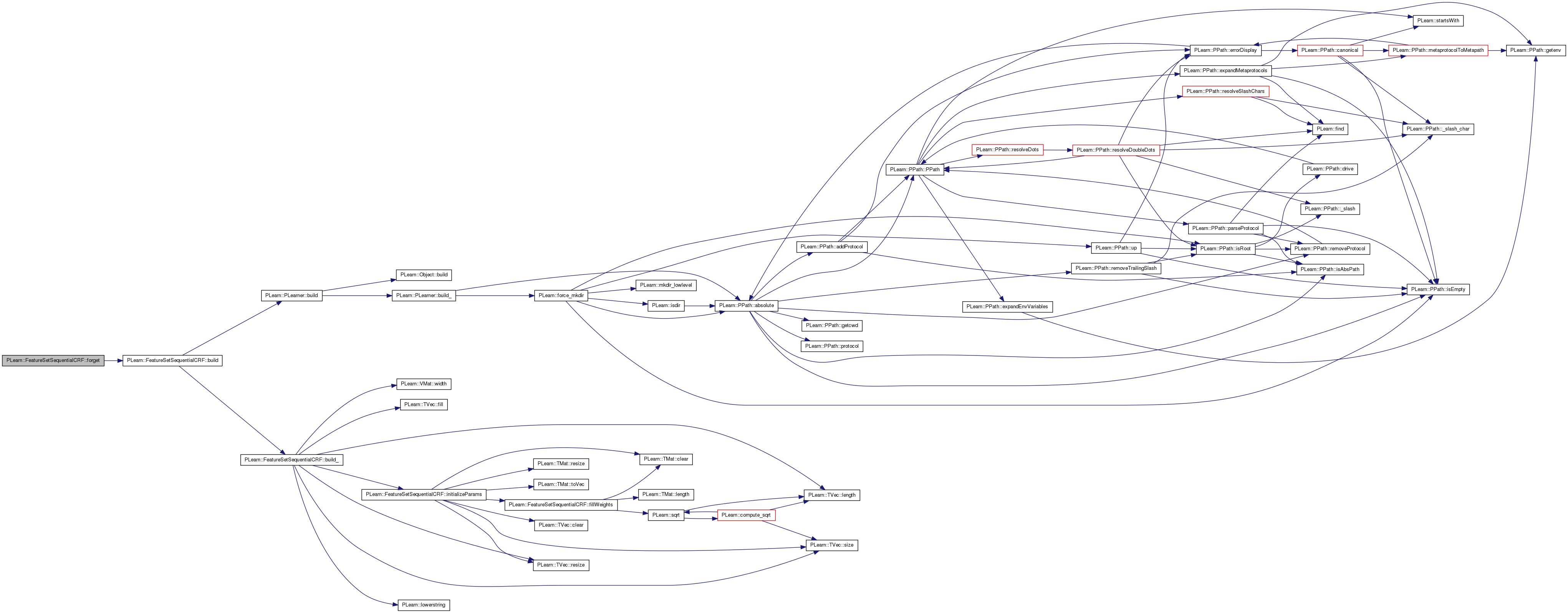
| void PLearn::FeatureSetSequentialCRF::fprop | ( | const Vec & | inputv, |
| Vec & | outputv, | ||
| const Vec & | targetv, | ||
| Vec & | costsv, | ||
| real | sampleweight = 1 |
||
| ) | const [protected] |
Forward propagation in the network.
Definition at line 346 of file FeatureSetSequentialCRF.cc.
References fpropCostsFromOutput(), and fpropOutput().
Referenced by computeOutputAndCosts(), verify_gradient(), and verify_gradient_affine_transform().
{
fpropOutput(inputv,outputv);
//if(is_missing(outputv[0]))
// cout << "What the fuck" << endl;
fpropCostsFromOutput(inputv, outputv, targetv, costsv, sampleweight);
//if(is_missing(costsv[0]))
// cout << "Re-What the fuck" << endl;
}
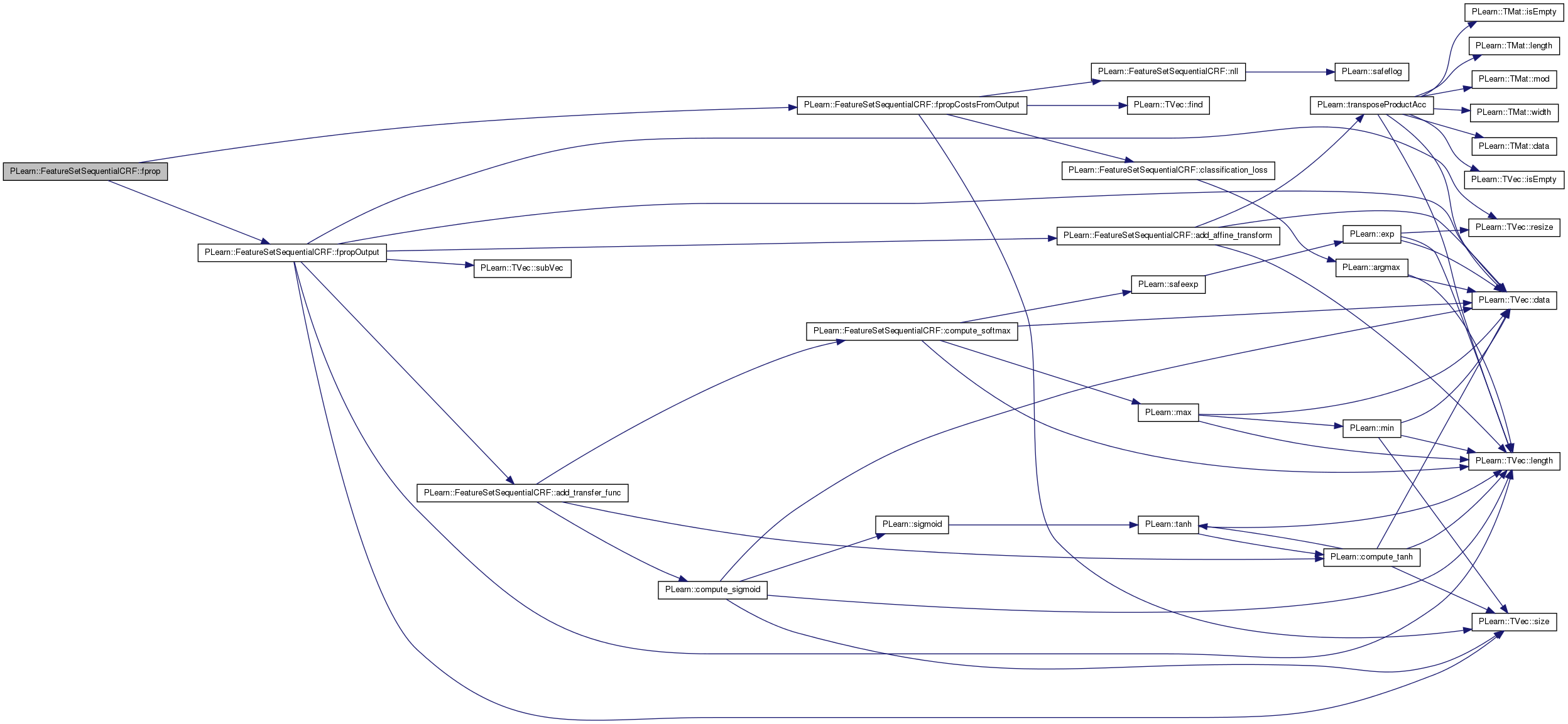

| void PLearn::FeatureSetSequentialCRF::fpropCostsFromOutput | ( | const Vec & | inputv, |
| const Vec & | outputv, | ||
| const Vec & | targetv, | ||
| Vec & | costsv, | ||
| real | sampleweight = 1 |
||
| ) | const [protected] |
Forward propagation to compute the costs from the output.
Definition at line 472 of file FeatureSetSequentialCRF.cc.
References classification_loss(), cost_funcs, PLearn::TVec< T >::find(), nll(), PLERROR, possible_targets_vary, reind_target, PLearn::TVec< T >::size(), and target_values.
Referenced by fprop().
{
//Compute cost
if(possible_targets_vary)
{
reind_target = target_values.find(targetv[0]);
if(reind_target<0)
PLERROR("In FeatureSetSequentialCRF::fprop(): target %d is not in possible targets", targetv[0]);
}
else
reind_target = (int)targetv[0];
// Build cost function
int ncosts = cost_funcs.size();
for(int k=0; k<ncosts; k++)
{
if(cost_funcs[k]=="NLL")
{
costsv[k] = sampleweight*nll(outputv,reind_target);
}
else if(cost_funcs[k]=="class_error")
costsv[k] = sampleweight*classification_loss(outputv, reind_target);
else
PLERROR("In FeatureSetSequentialCRF::fprop(): unknown cost_func option: %s",cost_funcs[k].c_str());
}
}


| void PLearn::FeatureSetSequentialCRF::fpropOutput | ( | const Vec & | inputv, |
| Vec & | outputv | ||
| ) | const [protected] |
Forward propagation to compute the output.
Definition at line 358 of file FeatureSetSequentialCRF.cc.
References add_affine_transform(), add_transfer_func(), b1, b2, bout, bout_dist_rep, PLearn::TVec< T >::data(), direct_bout, direct_in_to_out, direct_wout, dist_rep_dim, f, feat_input, feat_sets, feats, hidden2v, hiddenv, i, ifeats, PLearn::PLearner::inputsize_, j, last_layer, PLearn::TVec< T >::length(), n_feat_sets, nfeats, nhidden, nhidden2, ni, nj, nnet_input, offset, output_transfer_func, PLERROR, possible_targets_vary, PLearn::TVec< T >::resize(), row, PLearn::TVec< T >::size(), str, PLearn::TVec< T >::subVec(), target_values, target_values_reference_set, val_string_reference_set, w1, w2, wout, and wout_dist_rep.
Referenced by computeOutput(), and fprop().
{
// Get possible target values
if(possible_targets_vary)
{
row.subVec(0,inputsize_) << inputv;
target_values_reference_set->getValues(row,inputsize_,target_values);
outputv.resize(target_values.length());
}
// Get features
ni = inputsize_;
nfeats = 0;
for(int i=0; i<ni; i++)
{
str = val_string_reference_set->getValString(i,inputv[i]);
feat_sets[i%n_feat_sets]->getFeatures(str,feats[i]);
nfeats += feats[i].length();
}
feat_input.resize(nfeats);
offset = 0;
id = 0;
for(int i=0; i<ni; i++)
{
f = feats[i].data();
nj = feats[i].length();
for(int j=0; j<nj; j++)
feat_input[id++] = offset + *f++;
if(dist_rep_dim <= 0 || ((i+1) % n_feat_sets != 0))
offset += feat_sets[i % n_feat_sets]->size();
else
offset = 0;
}
// Fprop to output
if(dist_rep_dim > 0) // x -> d(x)
{
nfeats = 0;
id = 0;
for(int i=0; i<inputsize_;)
{
ifeats = 0;
for(int j=0; j<n_feat_sets; j++,i++)
ifeats += feats[i].length();
add_affine_transform(feat_input.subVec(nfeats,ifeats),
wout_dist_rep, bout_dist_rep,
nnet_input.subVec(id*dist_rep_dim,dist_rep_dim),
true, false);
nfeats += ifeats;
id++;
}
if(nhidden>0) // d(x) -> h1(d(x))
{
add_affine_transform(nnet_input,w1,b1,hiddenv,false,false);
add_transfer_func(hiddenv);
if(nhidden2>0) // h1(d(x)) -> h2(h1(d(x)))
{
add_affine_transform(hiddenv,w2,b2,hidden2v,false,false);
add_transfer_func(hidden2v);
last_layer = hidden2v;
}
else
last_layer = hiddenv;
}
else
last_layer = nnet_input;
// d(x),h1(d(x)),h2(h1(d(x))) -> o(x)
add_affine_transform(last_layer,wout,bout,outputv,false,
possible_targets_vary,target_values);
if(direct_in_to_out && nhidden>0)
add_affine_transform(nnet_input,direct_wout,direct_bout,
outputv,false,possible_targets_vary,target_values);
}
else
{
if(nhidden>0) // x -> h1(x)
{
add_affine_transform(feat_input,w1,b1,hiddenv,true,false);
// Transfert function
add_transfer_func(hiddenv);
if(nhidden2>0) // h1(x) -> h2(h1(x))
{
add_affine_transform(hiddenv,w2,b2,hidden2v,true,false);
add_transfer_func(hidden2v);
last_layer = hidden2v;
}
else
last_layer = hiddenv;
}
else
last_layer = feat_input;
// x, h1(x),h2(h1(x)) -> o(x)
add_affine_transform(last_layer,wout,bout,outputv,nhidden<=0,
possible_targets_vary,target_values);
if(direct_in_to_out && nhidden>0)
add_affine_transform(feat_input,direct_wout,direct_bout,
outputv,true,possible_targets_vary,target_values);
}
if (nhidden2>0 && nhidden<=0)
PLERROR("FeatureSetSequentialCRF::fprop(): can't have nhidden2 (=%d) > 0 while nhidden=0",nhidden2);
if(output_transfer_func!="" && output_transfer_func!="none")
add_transfer_func(outputv, output_transfer_func);
}
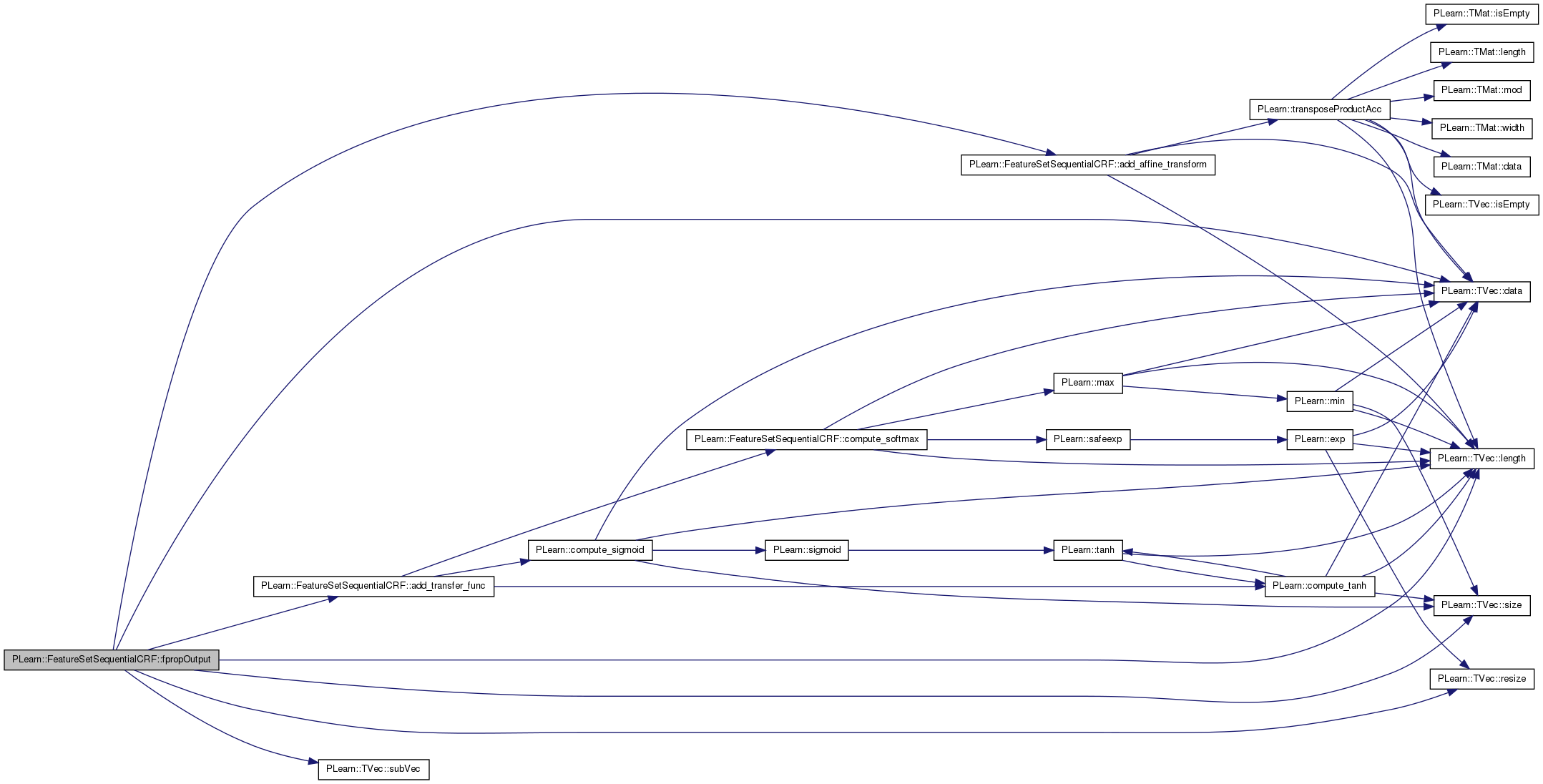

| OptionList & PLearn::FeatureSetSequentialCRF::getOptionList | ( | ) | const [virtual] |
Reimplemented from PLearn::Object.
Definition at line 51 of file FeatureSetSequentialCRF.cc.
| OptionMap & PLearn::FeatureSetSequentialCRF::getOptionMap | ( | ) | const [virtual] |
Reimplemented from PLearn::Object.
Definition at line 51 of file FeatureSetSequentialCRF.cc.
| RemoteMethodMap & PLearn::FeatureSetSequentialCRF::getRemoteMethodMap | ( | ) | const [virtual] |
Reimplemented from PLearn::Object.
Definition at line 51 of file FeatureSetSequentialCRF.cc.
| TVec< string > PLearn::FeatureSetSequentialCRF::getTestCostNames | ( | ) | const [virtual] |
*** SUBCLASS WRITING: ***
This should return the names of the costs computed by computeCostsFromOutputs.
Implements PLearn::PLearner.
Definition at line 913 of file FeatureSetSequentialCRF.cc.
References cost_funcs.
{
return cost_funcs;
}
| TVec< string > PLearn::FeatureSetSequentialCRF::getTrainCostNames | ( | ) | const [virtual] |
*** SUBCLASS WRITING: ***
This should return the names of the objective costs that the train method computes and for which it updates the VecStatsCollector train_stats.
Implements PLearn::PLearner.
Definition at line 905 of file FeatureSetSequentialCRF.cc.
References cost_funcs.
Referenced by verify_gradient().
{
return cost_funcs;
}

| void PLearn::FeatureSetSequentialCRF::gradient_affine_transform | ( | Vec | input, |
| Mat | weights, | ||
| Vec | bias, | ||
| Vec | ginput, | ||
| Mat | gweights, | ||
| Vec | gbias, | ||
| Vec | goutput, | ||
| bool | input_is_sparse, | ||
| bool | output_is_sparse, | ||
| real | learning_rate, | ||
| real | weight_decay, | ||
| real | bias_decay, | ||
| Vec | output_indices = Vec(0) |
||
| ) | [protected] |
Propagate gradient through affine transform on input using provided weights and bias.
Information about the nature of the input and output need to be provided. If bias.length() == 0, then no backprop is made to bias.
Definition at line 1112 of file FeatureSetSequentialCRF.cc.
References bias_decay, PLearn::TVec< T >::data(), PLearn::fast_exact_is_equal(), i, j, PLearn::TVec< T >::length(), ni, nj, penalty_type, pval1, pval2, pval3, pval4, pval5, PLearn::two(), val, val2, and weight_decay.
Referenced by bprop().
{
// Bias
if(bias.length() != 0)
{
if(output_is_sparse)
{
pval1 = gbias.data();
pval2 = goutput.data();
pval3 = output_indices.data();
ni = goutput.length();
if(fast_exact_is_equal(bias_decay, 0))
{
// Without bias decay
for(int i=0; i<ni; i++)
pval1[(int)*pval3++] += *pval2++;
}
else
{
// With bias decay
if(penalty_type == "L2_square")
{
pval4 = bias.data();
val = -two(learning_rate)*bias_decay;
for(int i=0; i<ni; i++)
{
pval1[(int)*pval3] += *pval2++ + val*(pval4[(int)*pval3]);
pval3++;
}
}
else if(penalty_type == "L1")
{
pval4 = bias.data();
val = -learning_rate*bias_decay;
for(int i=0; i<ni; i++)
{
val2 = pval4[(int)*pval3];
if(val2 > 0 )
pval1[(int)*pval3] += *pval2 + val;
else if(val2 < 0)
pval1[(int)*pval3] += *pval2 - val;
pval2++;
pval3++;
}
}
}
}
else
{
pval1 = gbias.data();
pval2 = goutput.data();
ni = goutput.length();
if(fast_exact_is_equal(bias_decay, 0))
{
// Without bias decay
for(int i=0; i<ni; i++)
*pval1++ += *pval2++;
}
else
{
// With bias decay
if(penalty_type == "L2_square")
{
pval3 = bias.data();
val = -two(learning_rate)*bias_decay;
for(int i=0; i<ni; i++)
{
*pval1++ += *pval2++ + val * (*pval3++);
}
}
else if(penalty_type == "L1")
{
pval3 = bias.data();
val = -learning_rate*bias_decay;
for(int i=0; i<ni; i++)
{
if(*pval3 > 0)
*pval1 += *pval2 + val;
else if(*pval3 < 0)
*pval1 += *pval2 - val;
pval1++;
pval2++;
pval3++;
}
}
}
}
}
// Weights and input (when appropriate)
if(!input_is_sparse && !output_is_sparse)
{
// Input
//productAcc(ginput, weights, goutput);
// Weights
//externalProductAcc(gweights, input, goutput);
// Faster code to do this, which limits the accesses
// to memory
ni = input.length();
nj = goutput.length();
pval3 = ginput.data();
pval5 = input.data();
if(fast_exact_is_equal(weight_decay, 0))
{
// Without weight decay
for(int i=0; i<ni; i++) {
pval1 = goutput.data();
pval2 = weights[i];
pval4 = gweights[i];
for(int j=0; j<nj; j++) {
*pval3 += *pval2 * (*pval1);
*pval4 += *pval5 * (*pval1);
pval1++;
pval2++;
pval4++;
}
pval3++;
pval5++;
}
}
else
{
//With weight decay
if(penalty_type == "L2_square")
{
val = -two(learning_rate)*weight_decay;
for(int i=0; i<ni; i++) {
pval1 = goutput.data();
pval2 = weights[i];
pval4 = gweights[i];
for(int j=0; j<nj; j++) {
*pval3 += *pval2 * (*pval1);
*pval4 += *pval5 * (*pval1) + val * (*pval2);
pval1++;
pval2++;
pval4++;
}
pval3++;
pval5++;
}
}
else if(penalty_type == "L1")
{
val = -learning_rate*weight_decay;
for(int i=0; i<ni; i++) {
pval1 = goutput.data();
pval2 = weights[i];
pval4 = gweights[i];
for(int j=0; j<nj; j++) {
*pval3 += *pval2 * (*pval1);
if(*pval2 > 0)
*pval4 += *pval5 * (*pval1) + val;
else if(*pval2 < 0)
*pval4 += *pval5 * (*pval1) - val;
pval1++;
pval2++;
pval4++;
}
pval3++;
pval5++;
}
}
}
}
else if(!input_is_sparse && output_is_sparse)
{
ni = goutput.length();
nj = input.length();
pval1 = goutput.data();
pval3 = output_indices.data();
if(fast_exact_is_equal(weight_decay, 0))
{
// Without weight decay
for(int i=0; i<ni; i++)
{
pval2 = input.data();
pval4 = ginput.data();
for(int j=0; j<nj; j++)
{
// Input
*pval4++ += weights(j,(int)(*pval3))*(*pval1);
// Weights
gweights(j,(int)(*pval3)) += (*pval2++)*(*pval1);
}
pval1++;
pval3++;
}
}
else
{
// With weight decay
if(penalty_type == "L2_square")
{
val = -two(learning_rate)*weight_decay;
for(int i=0; i<ni; i++)
{
pval2 = input.data();
pval4 = ginput.data();
for(int j=0; j<nj; j++)
{
val2 = weights(j,(int)(*pval3));
// Input
*pval4++ += val2*(*pval1);
// Weights
gweights(j,(int)(*pval3)) += (*pval2++)*(*pval1) + val*val2;
}
pval1++;
pval3++;
}
}
else if(penalty_type == "L1")
{
val = -learning_rate*weight_decay;
for(int i=0; i<ni; i++)
{
pval2 = input.data();
pval4 = ginput.data();
for(int j=0; j<nj; j++)
{
val2 = weights(j,(int)(*pval3));
// Input
*pval4++ += val2*(*pval1);
// Weights
if(val2 > 0)
gweights(j,(int)(*pval3)) += (*pval2)*(*pval1) + val;
else if(val2 < 0)
gweights(j,(int)(*pval3)) += (*pval2)*(*pval1) - val;
pval2++;
}
pval1++;
pval3++;
}
}
}
}
else if(input_is_sparse && !output_is_sparse)
{
ni = input.length();
nj = goutput.length();
if(fast_exact_is_equal(weight_decay, 0))
{
// Without weight decay
if(ni != 0)
{
pval3 = input.data();
for(int i=0; i<ni; i++)
{
pval1 = goutput.data();
pval2 = gweights[(int)(*pval3++)];
for(int j=0; j<nj;j++)
*pval2++ += *pval1++;
}
}
}
else
{
// With weight decay
if(penalty_type == "L2_square")
{
if(ni != 0)
{
pval3 = input.data();
val = -two(learning_rate)*weight_decay;
for(int i=0; i<ni; i++)
{
pval1 = goutput.data();
pval2 = gweights[(int)(*pval3)];
pval4 = weights[(int)(*pval3++)];
for(int j=0; j<nj;j++)
{
*pval2++ += *pval1++ + val * (*pval4++);
}
}
}
}
else if(penalty_type == "L1")
{
if(ni != 0)
{
pval3 = input.data();
val = learning_rate*weight_decay;
for(int i=0; i<ni; i++)
{
pval1 = goutput.data();
pval2 = gweights[(int)(*pval3)];
pval4 = weights[(int)(*pval3++)];
for(int j=0; j<nj;j++)
{
if(*pval4 > 0)
*pval2 += *pval1 + val;
else if(*pval4 < 0)
*pval2 += *pval1 - val;
pval1++;
pval2++;
pval4++;
}
}
}
}
}
}
else if(input_is_sparse && output_is_sparse)
{
ni = input.length();
nj = goutput.length();
if(fast_exact_is_equal(weight_decay, 0))
{
// Without weight decay
if(ni != 0)
{
pval2 = input.data();
for(int i=0; i<ni; i++)
{
pval1 = goutput.data();
pval3 = output_indices.data();
for(int j=0; j<nj; j++)
gweights((int)(*pval2),(int)*pval3++) += *pval1++;
pval2++;
}
}
}
else
{
// With weight decay
if(penalty_type == "L2_square")
{
if(ni != 0)
{
pval2 = input.data();
val = -two(learning_rate)*weight_decay;
for(int i=0; i<ni; i++)
{
pval1 = goutput.data();
pval3 = output_indices.data();
for(int j=0; j<nj; j++)
{
gweights((int)(*pval2),(int)*pval3)
+= *pval1++
+ val * weights((int)(*pval2),(int)*pval3);
pval3++;
}
pval2++;
}
}
}
else if(penalty_type == "L1")
{
if(ni != 0)
{
pval2 = input.data();
val = -learning_rate*weight_decay;
for(int i=0; i<ni; i++)
{
pval1 = goutput.data();
pval3 = output_indices.data();
for(int j=0; j<nj; j++)
{
val2 = weights((int)(*pval2),(int)*pval3);
if(val2 > 0)
gweights((int)(*pval2),(int)*pval3)
+= *pval1 + val;
else if(val2 < 0)
gweights((int)(*pval2),(int)*pval3)
+= *pval1 - val;
pval1++;
pval3++;
}
pval2++;
}
}
}
}
}
// gradient_penalty(input,weights,bias,gweights,gbias,input_is_sparse,output_is_sparse,
// learning_rate,weight_decay,bias_decay,output_indices);
}


| void PLearn::FeatureSetSequentialCRF::gradient_penalty | ( | Vec | input, |
| Mat | weights, | ||
| Vec | bias, | ||
| Mat | gweights, | ||
| Vec | gbias, | ||
| bool | input_is_sparse, | ||
| bool | output_is_sparse, | ||
| real | learning_rate, | ||
| real | weight_decay, | ||
| real | bias_decay, | ||
| Vec | output_indices = Vec(0) |
||
| ) | [protected] |
Propagate penalty gradient through weights and bias, scaled by -learning rate.
Definition at line 1505 of file FeatureSetSequentialCRF.cc.
References PLearn::TMat< T >::begin(), bias_decay, PLearn::TMat< T >::compact_begin(), PLearn::TMat< T >::compact_end(), PLearn::TVec< T >::data(), PLearn::TMat< T >::end(), PLearn::fast_exact_is_equal(), i, PLearn::TMat< T >::isCompact(), j, PLearn::TVec< T >::length(), PLearn::multiplyAcc(), ni, nj, penalty_type, pval1, pval2, pval3, PLearn::two(), val, val2, and weight_decay.
{
// Bias
if(!fast_exact_is_equal(bias_decay, 0) && !fast_exact_is_equal(bias.length(), 0) )
{
if(output_is_sparse)
{
pval1 = gbias.data();
pval2 = bias.data();
pval3 = output_indices.data();
ni = output_indices.length();
if(penalty_type == "L2_square")
{
val = -two(learning_rate)*bias_decay;
for(int i=0; i<ni; i++)
{
pval1[(int)*pval3] += val*(pval2[(int)*pval3]);
pval3++;
}
}
else if(penalty_type == "L1")
{
val = -learning_rate*bias_decay;
for(int i=0; i<ni; i++)
{
val2 = pval2[(int)*pval3];
if(val2 > 0 )
pval1[(int)*pval3++] += val;
else if(val2 < 0)
pval1[(int)*pval3++] -= val;
}
}
}
else
{
pval1 = gbias.data();
pval2 = bias.data();
ni = output_indices.length();
if(penalty_type == "L2_square")
{
val = -two(learning_rate)*bias_decay;
for(int i=0; i<ni; i++)
*pval1++ += val*(*pval2++);
}
else if(penalty_type == "L1")
{
val = -learning_rate*bias_decay;
for(int i=0; i<ni; i++)
{
if(*pval2 > 0)
*pval1 += val;
else if(*pval2 < 0)
*pval1 -= val;
pval1++;
pval2++;
}
}
}
}
// Weights
if(!fast_exact_is_equal(weight_decay, 0))
{
if(!input_is_sparse && !output_is_sparse)
{
if(penalty_type == "L2_square")
{
multiplyAcc(gweights, weights,-two(learning_rate)*weight_decay);
}
else if(penalty_type == "L1")
{
val = -learning_rate*weight_decay;
if(gweights.isCompact() && weights.isCompact())
{
Mat::compact_iterator itm = gweights.compact_begin();
Mat::compact_iterator itmend = gweights.compact_end();
Mat::compact_iterator itx = weights.compact_begin();
for(; itm!=itmend; ++itm, ++itx)
{
if(*itx > 0)
*itm += val;
else if(*itx < 0)
*itm -= val;
}
}
else // use non-compact iterators
{
Mat::iterator itm = gweights.begin();
Mat::iterator itmend = gweights.end();
Mat::iterator itx = weights.begin();
for(; itm!=itmend; ++itm, ++itx)
{
if(*itx > 0)
*itm += val;
else if(*itx < 0)
*itm -= val;
}
}
}
}
else if(!input_is_sparse && output_is_sparse)
{
ni = output_indices.length();
nj = input.length();
pval1 = output_indices.data();
if(penalty_type == "L2_square")
{
val = -two(learning_rate)*weight_decay;
for(int i=0; i<ni; i++)
{
for(int j=0; j<nj; j++)
{
gweights(j,(int)(*pval1)) += val * weights(j,(int)(*pval1));
}
pval1++;
}
}
else if(penalty_type == "L1")
{
val = -learning_rate*weight_decay;
for(int i=0; i<ni; i++)
{
for(int j=0; j<nj; j++)
{
val2 = weights(j,(int)(*pval1));
if(val2 > 0)
gweights(j,(int)(*pval1)) += val;
else if(val2 < 0)
gweights(j,(int)(*pval1)) -= val;
}
pval1++;
}
}
}
else if(input_is_sparse && !output_is_sparse)
{
ni = input.length();
nj = output_indices.length();
if(ni != 0)
{
pval3 = input.data();
if(penalty_type == "L2_square")
{
val = -two(learning_rate)*weight_decay;
for(int i=0; i<ni; i++)
{
pval1 = weights[(int)(*pval3)];
pval2 = gweights[(int)(*pval3++)];
for(int j=0; j<nj;j++)
*pval2++ += val * *pval1++;
}
}
else if(penalty_type == "L1")
{
val = -learning_rate*weight_decay;
for(int i=0; i<ni; i++)
{
pval1 = weights[(int)(*pval3)];
pval2 = gweights[(int)(*pval3++)];
for(int j=0; j<nj;j++)
{
if(*pval1 > 0)
*pval2 += val;
else if(*pval1 < 0)
*pval2 -= val;
pval2++;
pval1++;
}
}
}
}
}
else if(input_is_sparse && output_is_sparse)
{
ni = input.length();
nj = output_indices.length();
if(ni != 0)
{
pval1 = input.data();
if(penalty_type == "L2_square")
{
val = -two(learning_rate)*weight_decay;
for(int i=0; i<ni; i++)
{
pval2 = output_indices.data();
for(int j=0; j<nj; j++)
{
gweights((int)(*pval1),(int)*pval2) += val*weights((int)(*pval1),(int)*pval2);
pval2++;
}
pval1++;
}
}
else if(penalty_type == "L1")
{
val = -learning_rate*weight_decay;
for(int i=0; i<ni; i++)
{
pval2 = output_indices.data();
for(int j=0; j<nj; j++)
{
val2 = weights((int)(*pval1),(int)*pval2);
if(val2 > 0)
gweights((int)(*pval1),(int)*pval2) += val;
else if(val2 < 0)
gweights((int)(*pval1),(int)*pval2) -= val;
pval2++;
}
pval1++;
}
}
}
}
}
}
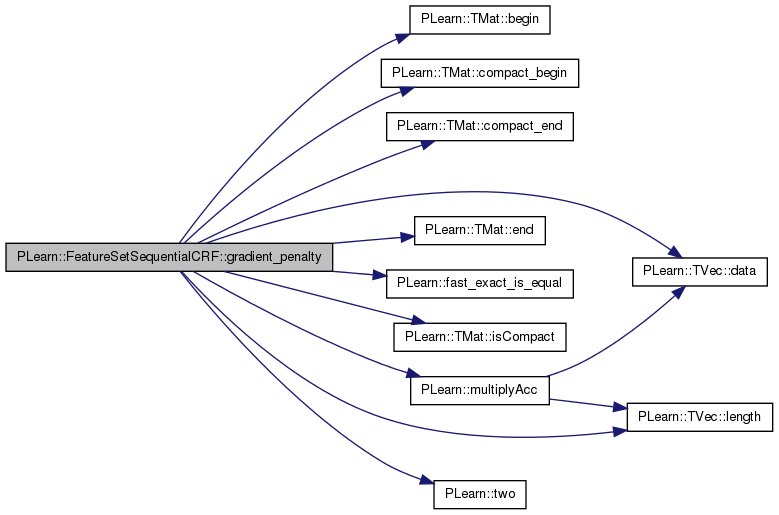
| void PLearn::FeatureSetSequentialCRF::gradient_transfer_func | ( | Vec & | output, |
| Vec & | gradient_input, | ||
| Vec & | gradient_output, | ||
| string | transfer_func = "default", |
||
| int | nll_softmax_speed_up_target = -1 |
||
| ) | [protected] |
Computes the gradient through the given activation function, the output value and the initial gradient on that output (i.e.
before the activation function). After calling this function, gradient_act_output corresponds the gradient after the activation function. nll_softmax_speed_up_target is to speed up the gradient computation for the output layer using the softmax transfert function and the NLL cost function is applied.
Definition at line 948 of file FeatureSetSequentialCRF.cc.
References PLearn::TVec< T >::data(), grad, hidden_transfer_func, i, PLearn::TVec< T >::length(), ni, nk, PLERROR, pval1, pval2, pval3, PLearn::square(), and val.
Referenced by bprop().
{
if (transfer_func == "default")
transfer_func = hidden_transfer_func;
if(transfer_func=="linear")
{
pval1 = gradient_output.data();
pval2 = gradient_input.data();
ni = output.length();
for(int i=0; i<ni; i++)
*pval2++ += *pval1++;
return;
}
else if(transfer_func=="tanh")
{
pval1 = gradient_output.data();
pval2 = output.data();
pval3 = gradient_input.data();
ni = output.length();
for(int i=0; i<ni; i++)
*pval3++ += (*pval1++)*(1.0-square(*pval2++));
return;
}
else if(transfer_func=="sigmoid")
{
pval1 = gradient_output.data();
pval2 = output.data();
pval3 = gradient_input.data();
ni = output.length();
for(int i=0; i<ni; i++)
{
*pval3++ += (*pval1++)*(*pval2)*(1.0-*pval2);
pval2++;
}
return;
}
else if(transfer_func=="softmax")
{
if(nll_softmax_speed_up_target<0)
{
pval3 = gradient_input.data();
ni = nk = output.length();
for(int i=0; i<ni; i++)
{
val = output[i];
pval1 = gradient_output.data();
pval2 = output.data();
for(int k=0; k<nk; k++)
if(k!=i)
*pval3 -= *pval1++ * val * (*pval2++);
else
{
*pval3 += *pval1++ * val * (1.0-val);
pval2++;
}
pval3++;
}
}
else // Permits speedup and avoids numerical precision errors
{
pval2 = output.data();
pval3 = gradient_input.data();
ni = output.length();
grad = gradient_output[nll_softmax_speed_up_target];
val = output[nll_softmax_speed_up_target];
for(int i=0; i<ni; i++)
{
if(nll_softmax_speed_up_target!=i)
//*pval3++ -= grad * val * (*pval2++);
*pval3++ -= grad * (*pval2++);
else
{
//*pval3++ += grad * val * (1.0-val);
*pval3++ += grad * (1.0-val);
pval2++;
}
}
}
return;
}
else PLERROR("In FeatureSetSequentialCRF::gradient_transfer_func(): Unknown value for transfer_func: %s",transfer_func.c_str());
}


| void PLearn::FeatureSetSequentialCRF::initializeParams | ( | bool | set_seed = true | ) | [protected, virtual] |
Initialize the parameters.
If 'set_seed' is set to false, the seed will not be set in this method (it will be assumed to be already initialized according to the 'seed' option). The index of the extra task (-1 if main task) also needs to be provided.
Definition at line 1766 of file FeatureSetSequentialCRF.cc.
References b1, b2, bout, bout_dist_rep, PLearn::TMat< T >::clear(), PLearn::TVec< T >::clear(), direct_bout, direct_in_to_out, direct_wout, dist_rep_dim, feat_input, feat_sets, fillWeights(), fixed_output_weights, gradient_act_hidden2v, gradient_act_hiddenv, gradient_act_outputv, gradient_b1, gradient_b2, gradient_bout, gradient_bout_dist_rep, gradient_direct_bout, gradient_direct_wout, gradient_hidden2v, gradient_hiddenv, gradient_nnet_input, gradient_outputv, gradient_w1, gradient_w2, gradient_wout, gradient_wout_dist_rep, hidden2v, hiddenv, i, PLearn::PLearner::inputsize_, n_feat_sets, nhidden, nhidden2, nnet_input, PLearn::TMat< T >::resize(), PLearn::TVec< T >::resize(), rgen, PLearn::PLearner::seed_, PLearn::TVec< T >::size(), total_feats_per_token, total_output_size, PLearn::TMat< T >::toVec(), PLearn::PLearner::train_set, w1, w2, wout, and wout_dist_rep.
Referenced by build_().
{
if (set_seed) {
if (seed_>=0)
rgen->manual_seed(seed_);
}
PP<Dictionary> dict = train_set->getDictionary(inputsize_);
total_output_size = dict->size();
total_feats_per_token = 0;
for(int i=0; i<n_feat_sets; i++)
total_feats_per_token += feat_sets[i]->size();
int nnet_inputsize;
if(dist_rep_dim > 0)
{
wout_dist_rep.resize(total_feats_per_token,dist_rep_dim);
bout_dist_rep.resize(dist_rep_dim);
nnet_inputsize = dist_rep_dim*inputsize_/n_feat_sets;
nnet_input.resize(nnet_inputsize);
fillWeights(wout_dist_rep);
bout_dist_rep.clear();
gradient_wout_dist_rep.resize(total_feats_per_token,dist_rep_dim);
gradient_bout_dist_rep.resize(dist_rep_dim);
gradient_nnet_input.resize(nnet_inputsize);
gradient_wout_dist_rep.clear();
gradient_bout_dist_rep.clear();
gradient_nnet_input.clear();
}
else
{
nnet_inputsize = total_feats_per_token*inputsize_/n_feat_sets;
nnet_input = feat_input;
}
if(nhidden>0)
{
w1.resize(nnet_inputsize,nhidden);
b1.resize(nhidden);
hiddenv.resize(nhidden);
fillWeights(w1);
b1.clear();
gradient_w1.resize(nnet_inputsize,nhidden);
gradient_b1.resize(nhidden);
gradient_hiddenv.resize(nhidden);
gradient_act_hiddenv.resize(nhidden);
gradient_w1.clear();
gradient_b1.clear();
gradient_hiddenv.clear();
gradient_act_hiddenv.clear();
if(nhidden2>0)
{
w2.resize(nhidden,nhidden2);
b2.resize(nhidden2);
hidden2v.resize(nhidden2);
wout.resize(nhidden2,total_output_size);
bout.resize(total_output_size);
fillWeights(w2);
b2.clear();
gradient_w2.resize(nhidden,nhidden2);
gradient_b2.resize(nhidden2);
gradient_hidden2v.resize(nhidden2);
gradient_act_hidden2v.resize(nhidden2);
gradient_wout.resize(nhidden2,total_output_size);
gradient_bout.resize(total_output_size);
gradient_w2.clear();
gradient_b2.clear();
gradient_hidden2v.clear();
gradient_act_hidden2v.clear();
gradient_wout.clear();
gradient_bout.clear();
}
else
{
wout.resize(nhidden,total_output_size);
bout.resize(total_output_size);
gradient_wout.resize(nhidden,total_output_size);
gradient_bout.resize(total_output_size);
gradient_wout.clear();
gradient_bout.clear();
}
if(direct_in_to_out)
{
direct_wout.resize(nnet_inputsize,total_output_size);
direct_bout.resize(0); // Because it is not used
fillWeights(direct_wout);
gradient_direct_wout.resize(nnet_inputsize,total_output_size);
gradient_direct_wout.clear();
gradient_direct_bout.resize(0); // idem
}
}
else
{
wout.resize(nnet_inputsize,total_output_size);
bout.resize(total_output_size);
gradient_wout.resize(nnet_inputsize,total_output_size);
gradient_bout.resize(total_output_size);
gradient_wout.clear();
gradient_bout.clear();
}
//fillWeights(wout);
if (fixed_output_weights) {
static Vec values;
if (values.size()==0)
{
values.resize(2);
values[0]=-1;
values[1]=1;
}
rgen->fill_random_discrete(wout.toVec(), values);
}
else
fillWeights(wout);
bout.clear();
gradient_outputv.resize(total_output_size);
gradient_act_outputv.resize(total_output_size);
gradient_outputv.clear();
gradient_act_outputv.clear();
}


| void PLearn::FeatureSetSequentialCRF::makeDeepCopyFromShallowCopy | ( | CopiesMap & | copies | ) | [virtual] |
Transforms a shallow copy into a deep copy.
Reimplemented from PLearn::PLearner.
Definition at line 1906 of file FeatureSetSequentialCRF.cc.
References b1, b2, bout, bout_dist_rep, cost_funcs, PLearn::deepCopyField(), direct_bout, direct_wout, feat_input, feat_sets, feats, feats_since_last_update, gradient, gradient_act_hidden2v, gradient_act_hiddenv, gradient_act_outputv, gradient_b1, gradient_b2, gradient_bout, gradient_bout_dist_rep, gradient_direct_bout, gradient_direct_wout, gradient_feat_input, gradient_hidden2v, gradient_hiddenv, gradient_last_layer, gradient_nnet_input, gradient_outputv, gradient_w1, gradient_w2, gradient_wout, gradient_wout_dist_rep, hidden2v, hiddenv, last_layer, PLearn::PLearner::makeDeepCopyFromShallowCopy(), nnet_input, output_comp, row, target_values, target_values_reference_set, target_values_since_last_update, val_string_reference_set, w1, w2, wout, and wout_dist_rep.
{
inherited::makeDeepCopyFromShallowCopy(copies);
// Private variables
deepCopyField(target_values,copies);
deepCopyField(output_comp,copies);
deepCopyField(row,copies);
deepCopyField(last_layer,copies);
deepCopyField(gradient_last_layer,copies);
deepCopyField(feats,copies);
deepCopyField(gradient,copies);
// Protected variables
deepCopyField(feat_input,copies);
deepCopyField(gradient_feat_input,copies);
deepCopyField(nnet_input,copies);
deepCopyField(gradient_nnet_input,copies);
deepCopyField(hiddenv,copies);
deepCopyField(gradient_hiddenv,copies);
deepCopyField(gradient_act_hiddenv,copies);
deepCopyField(hidden2v,copies);
deepCopyField(gradient_hidden2v,copies);
deepCopyField(gradient_act_hidden2v,copies);
deepCopyField(gradient_outputv,copies);
deepCopyField(gradient_act_outputv,copies);
deepCopyField(feats_since_last_update,copies);
deepCopyField(target_values_since_last_update,copies);
deepCopyField(val_string_reference_set,copies);
deepCopyField(target_values_reference_set,copies);
// Public variables
deepCopyField(w1,copies);
deepCopyField(gradient_w1,copies);
deepCopyField(b1,copies);
deepCopyField(gradient_b1,copies);
deepCopyField(w2,copies);
deepCopyField(gradient_w2,copies);
deepCopyField(b2,copies);
deepCopyField(gradient_b2,copies);
deepCopyField(wout,copies);
deepCopyField(gradient_wout,copies);
deepCopyField(bout,copies);
deepCopyField(gradient_bout,copies);
deepCopyField(direct_wout,copies);
deepCopyField(gradient_direct_wout,copies);
deepCopyField(direct_bout,copies);
deepCopyField(gradient_direct_bout,copies);
deepCopyField(wout_dist_rep,copies);
deepCopyField(gradient_wout_dist_rep,copies);
deepCopyField(bout_dist_rep,copies);
deepCopyField(gradient_bout_dist_rep,copies);
// Public build options
deepCopyField(cost_funcs,copies);
deepCopyField(feat_sets,copies);
}

| int PLearn::FeatureSetSequentialCRF::my_argmax | ( | const Vec & | vec, |
| int | default_compare = 0 |
||
| ) | const [private] |
Argmax function that lets you define the default (first) component used for comparisons.
This is useful to avoid bias in the prediction when the getValues() provides some information about the prior distribution of the targets (e.g. the first target given by getValues() is the most likely) and the output of the model is the same for all targets.
Definition at line 821 of file FeatureSetSequentialCRF.cc.
References PLearn::TVec< T >::data(), i, PLearn::TVec< T >::length(), and PLERROR.
Referenced by computeOutput(), and computeOutputAndCosts().
{
#ifdef BOUNDCHECK
if(vec.length()==0)
PLERROR("IN int argmax(const TVec<T>& vec) vec has zero length");
#endif
real* v = vec.data();
int indexmax = default_compare;
real maxval = v[default_compare];
for(int i=0; i<vec.length(); i++)
if(v[i]>maxval)
{
maxval = v[i];
indexmax = i;
}
return indexmax;
}


Negative log-likelihood loss.
Definition at line 1756 of file FeatureSetSequentialCRF.cc.
References PLearn::safeflog().
Referenced by fpropCostsFromOutput().
{
return -safeflog(outputv[target]);
}


| void PLearn::FeatureSetSequentialCRF::output_gradient_verification | ( | Vec | grad, |
| Vec | est_grad | ||
| ) | [protected] |
Definition at line 2510 of file FeatureSetSequentialCRF.cc.
References PLearn::apply(), PLearn::argmax(), PLearn::dot(), PLearn::endl(), PLearn::FABS(), PLearn::fast_exact_is_equal(), i, PLearn::is_missing(), PLearn::TVec< T >::length(), PLearn::max(), MISSING_VALUE, and PLearn::norm().
Referenced by verify_gradient().
{
// Inspired from Func::verifyGradient()
Vec num = apply(grad - est_grad,(tRealFunc)FABS);
Vec denom = real(0.5)*apply(grad + est_grad,(tRealFunc)FABS);
for (int i = 0; i < num.length(); i++)
{
if (!fast_exact_is_equal(num[i], 0))
num[i] /= denom[i];
else
if(!fast_exact_is_equal(denom[i],0))
cout << "at position " << i << " num[i] == 0 but denom[i] = " << denom[i] << endl;
}
int pos = argmax(num);
cout << max(num) << " (at position " << pos << "/" << num.length()
<< ", computed = " << grad[pos] << " and estimated = "
<< est_grad[pos] << ")" << endl;
real norm_grad = norm(grad);
real norm_est_grad = norm(est_grad);
real cos_angle = fast_exact_is_equal(norm_grad*norm_est_grad,
0)
? MISSING_VALUE
: dot(grad,est_grad) /
(norm_grad*norm_est_grad);
if (cos_angle > 1)
cos_angle = 1; // Numerical imprecisions can lead to such situation.
cout << "grad.length() = " << grad.length() << endl;
cout << "cos(angle) : " << cos_angle << endl;
cout << "angle : " << ( is_missing(cos_angle) ? MISSING_VALUE
: acos(cos_angle) ) << endl;
}
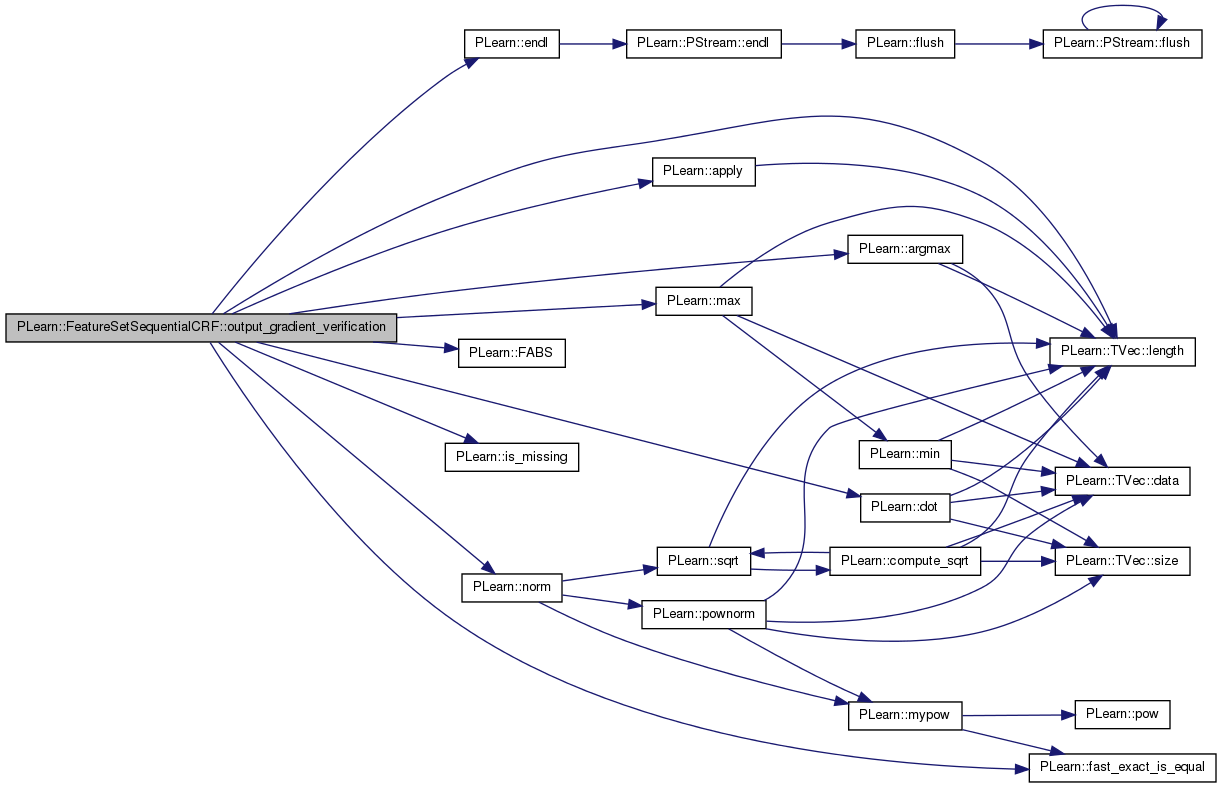

| int PLearn::FeatureSetSequentialCRF::outputsize | ( | ) | const [virtual] |
SUBCLASS WRITING: override this so that it returns the size of this learner's output, as a function of its inputsize(), targetsize() and set options.
Implements PLearn::PLearner.
Definition at line 1967 of file FeatureSetSequentialCRF.cc.
References PLearn::PLearner::targetsize_.
{
return targetsize_;
}
Changes the reference_set and then calls the parent's class method.
Reimplemented from PLearn::PLearner.
Definition at line 2574 of file FeatureSetSequentialCRF.cc.
References PLearn::PLearner::processDataSet(), target_values_reference_set, PLearn::PLearner::train_set, val_string_reference_set, and PLearn::VMat::width().
{
VMat ret;
val_string_reference_set = dataset;
// Assumes it contains the target part information
if(dataset->width() > train_set->inputsize())
target_values_reference_set = dataset;
ret = inherited::processDataSet(dataset);
val_string_reference_set = train_set;
if(dataset->width() > train_set->inputsize())
target_values_reference_set = train_set;
return ret;
}

| void PLearn::FeatureSetSequentialCRF::test | ( | VMat | testset, |
| PP< VecStatsCollector > | test_stats, | ||
| VMat | testoutputs = 0, |
||
| VMat | testcosts = 0 |
||
| ) | const [protected, virtual] |
Changes the reference_set and then calls the parent's class method.
Reimplemented from PLearn::PLearner.
Definition at line 2564 of file FeatureSetSequentialCRF.cc.
References target_values_reference_set, PLearn::PLearner::test(), PLearn::PLearner::train_set, and val_string_reference_set.
{
val_string_reference_set = testset;
target_values_reference_set = testset;
inherited::test(testset,test_stats,testoutputs,testcosts);
val_string_reference_set = train_set;
target_values_reference_set = train_set;
}
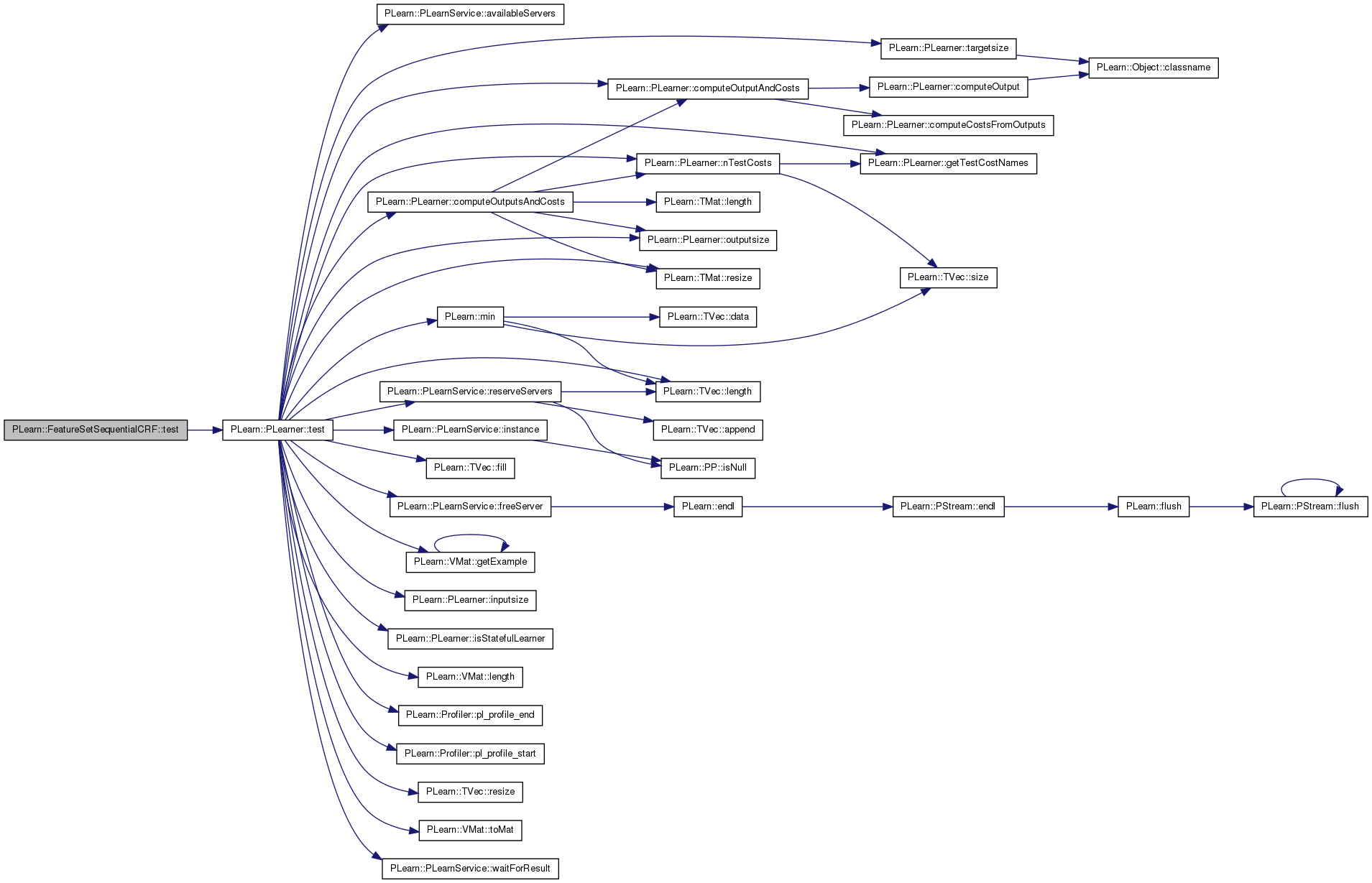
| void PLearn::FeatureSetSequentialCRF::train | ( | ) | [virtual] |
*** SUBCLASS WRITING: ***
The role of the train method is to bring the learner up to stage==nstages, updating the stats with training costs measured on-line in the process.
TYPICAL CODE:
static Vec input; // static so we don't reallocate/deallocate memory each time... static Vec target; // (but be careful that static means shared!) input.resize(inputsize()); // the train_set's inputsize() target.resize(targetsize()); // the train_set's targetsize() real weight; if(!train_stats) // make a default stats collector, in case there's none train_stats = new VecStatsCollector(); if(nstages<stage) // asking to revert to a previous stage! forget(); // reset the learner to stage=0 while(stage<nstages) { // clear statistics of previous epoch train_stats->forget(); //... train for 1 stage, and update train_stats, // using train_set->getSample(input, target, weight); // and train_stats->update(train_costs) ++stage; train_stats->finalize(); // finalize statistics for this epoch }
Implements PLearn::PLearner.
Definition at line 1974 of file FeatureSetSequentialCRF.cc.
References PLearn::PLearner::nstages, and PLearn::PLearner::stage.
{
//Profiler::activate();
// if(!train_set)
// PLERROR("In FeatureSetSequentialCRF::train, you did not setTrainingSet");
//
// if(!train_stats)
// PLERROR("In FeatureSetSequentialCRF::train, you did not setTrainStatsCollector");
//
// Vec outputv(total_output_size);
// Vec costsv(getTrainCostNames().length());
// Vec inputv(train_set->inputsize());
// Vec targetv(train_set->targetsize());
// real sample_weight=1;
//
//
// int l = train_set->length();
// int bs = batch_size>0 ? batch_size : l;
//
// PP<ProgressBar> pb;
// if(report_progress)
// pb = new ProgressBar("Training " + classname() + " from stage " + tostring(stage) + " to " + tostring(nstages), nstages-stage);
// Mat old_gradient_wout;
// Vec old_gradient_bout;
// Mat old_gradient_wout_dist_rep;
// Vec old_gradient_bout_dist_rep;
// Mat old_gradient_w1;
// Vec old_gradient_b1;
// Mat old_gradient_w2;
// Vec old_gradient_b2;
// Mat old_gradient_direct_wout;
//
// if(stochastic_gradient_descent_speedup)
// {
// // Trick to make stochastic gradient descent faster
//
// old_gradient_wout = gradient_wout;
// old_gradient_bout = gradient_bout;
// gradient_wout = wout;
// gradient_bout = bout;
//
// if(dist_rep_dim > 0)
// {
// old_gradient_wout_dist_rep = gradient_wout_dist_rep;
// old_gradient_bout_dist_rep = gradient_bout_dist_rep;
// gradient_wout_dist_rep = wout_dist_rep;
// gradient_bout_dist_rep = bout_dist_rep;
// }
//
// if(nhidden>0)
// {
// old_gradient_w1 = gradient_w1;
// old_gradient_b1 = gradient_b1;
// gradient_w1 = w1;
// gradient_b1 = b1;
// if(nhidden2>0)
// {
// old_gradient_w2 = gradient_w2;
// old_gradient_b2 = gradient_b2;
// gradient_w2 = w2;
// gradient_b2 = b2;
// }
//
// if(direct_in_to_out)
// {
// old_gradient_direct_wout = gradient_direct_wout;
// gradient_direct_wout = direct_wout;
// }
// }
// }
// Exemple TMat
// Mat blu(10,40);
// blu.resize(3,6);
// blu(2,3) <- élément à la position 2,3, partant de 0,0
// blu[1] <- pointer real* vers la 2e rangée (rangée 1)
//
// Note: tu peux faire des TVec< TVec< TVec<... > > >
// Supposer qu'ils sont définis...
TVec<int> delimiters;
int initial_stage = stage;
while(stage<nstages)
{
for(int t=0; t<l;)
{
// Coder ici Alexounet alpha-beta
// Update
//if(!stochastic_gradient_descent_speedup)
// update();
//total_updates++;
}
// train_stats->finalize();
// ++stage;
// if(verbosity>2)
// cout << "Epoch " << stage << " train objective: "
// << train_stats->getMean() << endl;
// if(pb) pb->update(stage-initial_stage);
}
// if(stochastic_gradient_descent_speedup)
// {
// // Trick to make stochastic gradient descent faster
//
// gradient_wout = old_gradient_wout;
// gradient_bout = old_gradient_bout;
//
// if(dist_rep_dim > 0)
// {
// gradient_wout_dist_rep = old_gradient_wout_dist_rep;
// gradient_bout_dist_rep = old_gradient_bout_dist_rep;
// }
//
// if(nhidden>0)
// {
// gradient_w1 = old_gradient_w1;
// gradient_b1 = old_gradient_b1;
// if(nhidden2>0)
// {
// gradient_w2 = old_gradient_w2;
// gradient_b2 = old_gradient_b2;
// }
//
// if(direct_in_to_out)
// {
// gradient_direct_wout = old_gradient_direct_wout;
// }
// }
// }
//Profiler::report(cout);
}
| void PLearn::FeatureSetSequentialCRF::update | ( | ) | [protected] |
Update network's parameters.
Definition at line 628 of file FeatureSetSequentialCRF.cc.
References b1, b2, bout, bout_dist_rep, direct_bout, direct_in_to_out, direct_wout, dist_rep_dim, feats_since_last_update, gradient_b1, gradient_b2, gradient_bout, gradient_bout_dist_rep, gradient_direct_bout, gradient_direct_wout, gradient_w1, gradient_w2, gradient_wout, gradient_wout_dist_rep, nhidden, nhidden2, possible_targets_vary, PLearn::TVec< T >::resize(), target_values_since_last_update, update_affine_transform(), w1, w2, wout, and wout_dist_rep.
{
if(dist_rep_dim > 0)
{
update_affine_transform(feats_since_last_update, wout_dist_rep,
bout_dist_rep, gradient_wout_dist_rep,
gradient_bout_dist_rep, true, false,
target_values_since_last_update);
}
if(nhidden>0)
{
update_affine_transform(feats_since_last_update, w1, b1,
gradient_w1, gradient_b1,
dist_rep_dim<=0, false,
target_values_since_last_update);
if(nhidden2>0)
{
update_affine_transform(feats_since_last_update, w2, b2,
gradient_w2, gradient_b2,
false, false,
target_values_since_last_update);
}
update_affine_transform(feats_since_last_update, wout, bout,
gradient_wout, gradient_bout,
false, possible_targets_vary,
target_values_since_last_update);
if(direct_in_to_out)
{
update_affine_transform(feats_since_last_update, direct_wout,
direct_bout,
gradient_direct_wout, gradient_direct_bout,
false, possible_targets_vary,
target_values_since_last_update);
}
}
else
{
update_affine_transform(feats_since_last_update, wout, bout,
gradient_wout, gradient_bout,
dist_rep_dim<=0, possible_targets_vary,
target_values_since_last_update);
}
feats_since_last_update.resize(0);
target_values_since_last_update.resize(0);
}

| void PLearn::FeatureSetSequentialCRF::update_affine_transform | ( | Vec | input, |
| Mat | weights, | ||
| Vec | bias, | ||
| Mat | gweights, | ||
| Vec | gbias, | ||
| bool | input_is_sparse, | ||
| bool | output_is_sparse, | ||
| Vec | output_indices | ||
| ) | [protected] |
Update affine transformation's parameters.
Definition at line 678 of file FeatureSetSequentialCRF.cc.
References PLearn::TMat< T >::data(), PLearn::TVec< T >::data(), i, PLearn::TMat< T >::isCompact(), j, PLearn::TMat< T >::length(), PLearn::TVec< T >::length(), ni, nj, PLERROR, pval1, pval2, pval3, and PLearn::TMat< T >::width().
Referenced by update().
{
// Bias
if(bias.length() != 0)
{
if(output_is_sparse)
{
pval1 = gbias.data();
pval2 = bias.data();
pval3 = output_indices.data();
ni = output_indices.length();
for(int i=0; i<ni; i++)
{
pval2[(int)*pval3] += pval1[(int)*pval3];
pval1[(int)*pval3] = 0;
pval3++;
}
}
else
{
pval1 = gbias.data();
pval2 = bias.data();
ni = bias.length();
for(int i=0; i<ni; i++)
{
*pval2 += *pval1;
*pval1 = 0;
pval1++;
pval2++;
}
}
}
// Weights
if(!input_is_sparse && !output_is_sparse)
{
if(!gweights.isCompact() || !weights.isCompact())
PLERROR("In FeatureSetSequentialCRF::update_affine_transform(): weights or gweights is not a compact TMat");
ni = weights.length();
nj = weights.width();
pval1 = gweights.data();
pval2 = weights.data();
for(int i=0; i<ni; i++)
for(int j=0; j<nj; j++)
{
*pval2 += *pval1;
*pval1 = 0;
pval1++;
pval2++;
}
}
else if(!input_is_sparse && output_is_sparse)
{
ni = output_indices.length();
nj = input.length();
pval3 = output_indices.data();
for(int i=0; i<ni; i++)
{
for(int j=0; j<nj; j++)
{
weights(j,(int)*pval3) += gweights(j,(int)*pval3);
gweights(j,(int)*pval3) = 0;
}
pval3++;
}
}
else if(input_is_sparse && !output_is_sparse)
{
ni = input.length();
nj = weights.width();
pval3 = input.data();
for(int i=0; i<ni; i++)
{
pval1 = gweights[(int)(*pval3)];
pval2 = weights[(int)(*pval3++)];
for(int j=0; j<nj;j++)
{
*pval2 += *pval1;
*pval1 = 0;
pval1++;
pval2++;
}
}
}
else if(input_is_sparse && output_is_sparse)
{
// Weights
ni = input.length();
nj = output_indices.length();
pval2 = input.data();
for(int i=0; i<ni; i++)
{
pval3 = output_indices.data();
for(int j=0; j<nj; j++)
{
weights((int)(*pval2),(int)*pval3) += gweights((int)(*pval2),(int)*pval3);
gweights((int)(*pval2),(int)*pval3) = 0;
pval3++;
}
pval2++;
}
}
}
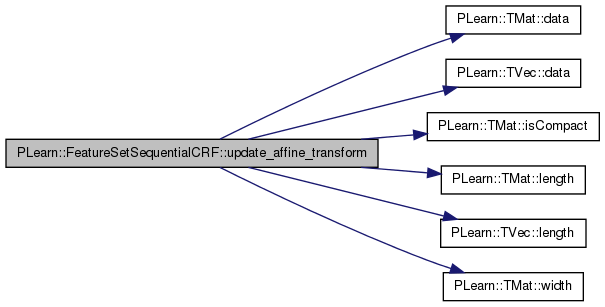

Changes the reference_set and then calls the parent's class method.
Reimplemented from PLearn::PLearner.
Definition at line 2552 of file FeatureSetSequentialCRF.cc.
References target_values_reference_set, PLearn::PLearner::train_set, PLearn::PLearner::use(), val_string_reference_set, and PLearn::VMat::width().
{
val_string_reference_set = testset;
if(testset->width() > train_set->inputsize())
target_values_reference_set = testset;
target_values_reference_set = testset;
inherited::use(testset,outputs);
val_string_reference_set = train_set;
if(testset->width() > train_set->inputsize())
target_values_reference_set = train_set;
}
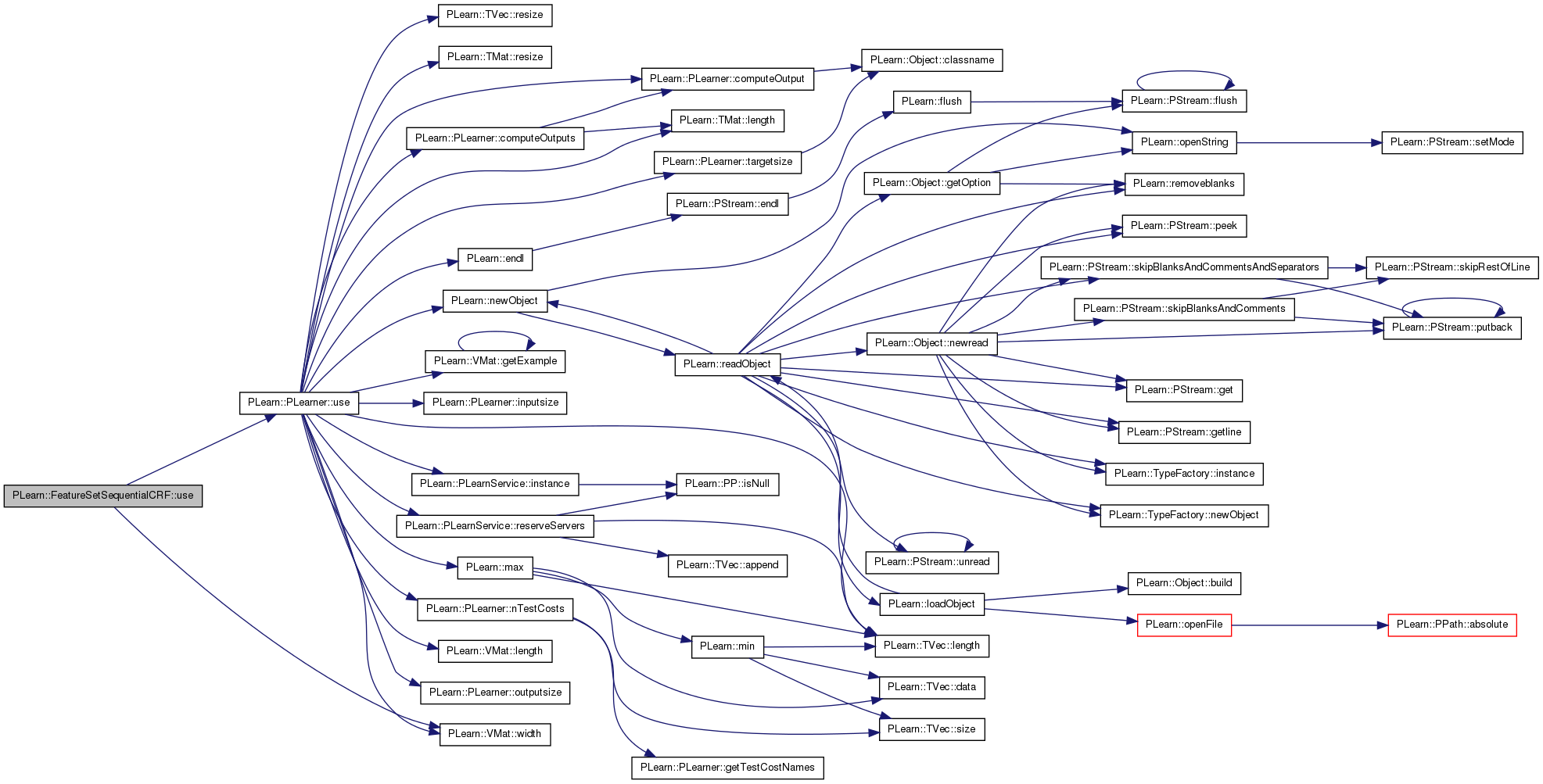
| void PLearn::FeatureSetSequentialCRF::verify_gradient | ( | Vec & | input, |
| Vec | target, | ||
| real | step | ||
| ) | [protected] |
Verify gradient of propagation path.
Definition at line 2110 of file FeatureSetSequentialCRF.cc.
References b1, b2, bout, bout_dist_rep, bprop(), PLearn::TMat< T >::clear(), PLearn::TVec< T >::clear(), clearProppathGradient(), direct_bout, direct_in_to_out, direct_wout, dist_rep_dim, PLearn::endl(), feat_input, feats, fprop(), getTrainCostNames(), gradient_b1, gradient_b2, gradient_bout, gradient_bout_dist_rep, gradient_direct_bout, gradient_direct_wout, gradient_w1, gradient_w2, gradient_wout, gradient_wout_dist_rep, hidden2v, hiddenv, i, ifeats, PLearn::PLearner::inputsize_, j, last_layer, n_feat_sets, nfeats, nhidden, nhidden2, nnet_input, output_comp, output_gradient_verification(), possible_targets_vary, PLearn::TMat< T >::resize(), PLearn::TVec< T >::resize(), PLearn::TVec< T >::subVec(), target_values, total_feats_per_token, total_output_size, PLearn::TMat< T >::toVec(), verify_gradient_affine_transform(), w1, w2, wout, and wout_dist_rep.
{
Vec costsv(getTrainCostNames().length());
real sampleweight = 1;
real verify_step = step;
// To avoid the interaction between fprop and this function
int nfeats = 0;
int id = 0;
int ifeats = 0;
Vec est_gradient_bout;
Mat est_gradient_wout;
Vec est_gradient_bout_dist_rep;
Mat est_gradient_wout_dist_rep;
Vec est_gradient_b1;
Mat est_gradient_w1;
Vec est_gradient_b2;
Mat est_gradient_w2;
Vec est_gradient_direct_bout;
Mat est_gradient_direct_wout;
int nnet_inputsize;
if(dist_rep_dim > 0)
{
nnet_inputsize = dist_rep_dim*inputsize_/n_feat_sets;
est_gradient_wout_dist_rep.resize(total_feats_per_token,dist_rep_dim);
est_gradient_bout_dist_rep.resize(dist_rep_dim);
est_gradient_wout_dist_rep.clear();
est_gradient_bout_dist_rep.clear();
gradient_wout_dist_rep.clear();
gradient_bout_dist_rep.clear();
}
else
{
nnet_inputsize = total_feats_per_token*inputsize_/n_feat_sets;
}
if(nhidden>0)
{
est_gradient_w1.resize(nnet_inputsize,nhidden);
est_gradient_b1.resize(nhidden);
est_gradient_w1.clear();
est_gradient_b1.clear();
gradient_w1.clear();
gradient_b1.clear();
if(nhidden2>0)
{
est_gradient_w2.resize(nhidden,nhidden2);
est_gradient_b2.resize(nhidden2);
est_gradient_wout.resize(nhidden2,total_output_size);
est_gradient_bout.resize(total_output_size);
est_gradient_w2.clear();
est_gradient_b2.clear();
est_gradient_wout.clear();
est_gradient_bout.clear();
gradient_w2.clear();
gradient_b2.clear();
gradient_wout.clear();
gradient_bout.clear();
}
else
{
est_gradient_wout.resize(nhidden,total_output_size);
est_gradient_bout.resize(total_output_size);
est_gradient_wout.clear();
est_gradient_bout.clear();
gradient_wout.clear();
gradient_bout.clear();
}
if(direct_in_to_out)
{
est_gradient_direct_wout.resize(nnet_inputsize,total_output_size);
est_gradient_direct_wout.clear();
est_gradient_direct_bout.resize(0); // idem
gradient_direct_wout.clear();
}
}
else
{
est_gradient_wout.resize(nnet_inputsize,total_output_size);
est_gradient_bout.resize(total_output_size);
est_gradient_wout.clear();
est_gradient_bout.clear();
gradient_wout.clear();
gradient_bout.clear();
}
fprop(input, output_comp, targetv, costsv);
bprop(input,output_comp,targetv,costsv,
-1, sampleweight);
clearProppathGradient();
// Compute estimated gradient
if(dist_rep_dim > 0)
{
nfeats = 0;
id = 0;
for(int i=0; i<inputsize_;)
{
ifeats = 0;
for(int j=0; j<n_feat_sets; j++,i++)
ifeats += feats[i].length();
verify_gradient_affine_transform(
input,output_comp, targetv, costsv, sampleweight,
feat_input.subVec(nfeats,ifeats),
wout_dist_rep, bout_dist_rep,
est_gradient_wout_dist_rep, est_gradient_bout_dist_rep,
true, false, verify_step);
nfeats += ifeats;
id++;
}
cout << "Verify wout_dist_rep" << endl;
output_gradient_verification(gradient_wout_dist_rep.toVec(), est_gradient_wout_dist_rep.toVec());
cout << "Verify bout_dist_rep" << endl;
output_gradient_verification(gradient_bout_dist_rep, est_gradient_bout_dist_rep);
gradient_wout_dist_rep.clear();
gradient_bout_dist_rep.clear();
if(nhidden>0)
{
verify_gradient_affine_transform(
input,output_comp, targetv, costsv, sampleweight,
nnet_input,w1,b1,
est_gradient_w1, est_gradient_b1, false,false, verify_step);
cout << "Verify w1" << endl;
output_gradient_verification(gradient_w1.toVec(), est_gradient_w1.toVec());
cout << "Verify b1" << endl;
output_gradient_verification(gradient_b1, est_gradient_b1);
if(nhidden2>0)
{
verify_gradient_affine_transform(
input,output_comp, targetv, costsv, sampleweight,
hiddenv,w2,b2,
est_gradient_w2, est_gradient_b2,
false,false, verify_step);
cout << "Verify w2" << endl;
output_gradient_verification(gradient_w2.toVec(), est_gradient_w2.toVec());
cout << "Verify b2" << endl;
output_gradient_verification(gradient_b2, est_gradient_b2);
last_layer = hidden2v;
}
else
last_layer = hiddenv;
}
else
last_layer = nnet_input;
verify_gradient_affine_transform(
input,output_comp, targetv, costsv, sampleweight,
last_layer,wout,bout,
est_gradient_wout, est_gradient_bout, false,
possible_targets_vary,verify_step,target_values);
cout << "Verify wout" << endl;
output_gradient_verification(gradient_wout.toVec(), est_gradient_wout.toVec());
cout << "Verify bout" << endl;
output_gradient_verification(gradient_bout, est_gradient_bout);
if(direct_in_to_out && nhidden>0)
{
verify_gradient_affine_transform(
input,output_comp, targetv, costsv, sampleweight,
nnet_input,direct_wout,direct_bout,
est_gradient_direct_wout, est_gradient_direct_bout,false,
possible_targets_vary, verify_step, target_values);
cout << "Verify direct_wout" << endl;
output_gradient_verification(gradient_direct_wout.toVec(), est_gradient_direct_wout.toVec());
//cout << "Verify direct_bout" << endl;
//output_gradient_verification(gradient_direct_bout, est_gradient_direct_bout);
}
}
else
{
if(nhidden>0)
{
verify_gradient_affine_transform(
input,output_comp, targetv, costsv, sampleweight,
feat_input,w1,b1,
est_gradient_w1, est_gradient_b1,
true,false, verify_step);
cout << "Verify w1" << endl;
output_gradient_verification(gradient_w1.toVec(), est_gradient_w1.toVec());
cout << "Verify b1" << endl;
output_gradient_verification(gradient_b1, est_gradient_b1);
if(nhidden2>0)
{
verify_gradient_affine_transform(
input,output_comp, targetv, costsv, sampleweight,
hiddenv,w2,b2,
est_gradient_w2, est_gradient_b2,true,false,
verify_step);
cout << "Verify w2" << endl;
output_gradient_verification(gradient_w2.toVec(), est_gradient_w2.toVec());
cout << "Verify b2" << endl;
output_gradient_verification(gradient_b2, est_gradient_b2);
last_layer = hidden2v;
}
else
last_layer = hiddenv;
}
else
last_layer = feat_input;
verify_gradient_affine_transform(
input,output_comp, targetv, costsv, sampleweight,
last_layer,wout,bout,
est_gradient_wout, est_gradient_bout, nhidden<=0,
possible_targets_vary,verify_step, target_values);
cout << "Verify wout" << endl;
output_gradient_verification(gradient_wout.toVec(), est_gradient_wout.toVec());
cout << "Verify bout" << endl;
output_gradient_verification(gradient_bout, est_gradient_bout);
if(direct_in_to_out && nhidden>0)
{
verify_gradient_affine_transform(
input,output_comp, targetv, costsv, sampleweight,
feat_input,direct_wout,direct_bout,
est_gradient_wout, est_gradient_bout,true,
possible_targets_vary, verify_step,target_values);
cout << "Verify direct_wout" << endl;
output_gradient_verification(gradient_direct_wout.toVec(), est_gradient_direct_wout.toVec());
cout << "Verify direct_bout" << endl;
output_gradient_verification(gradient_direct_bout, est_gradient_direct_bout);
}
}
}
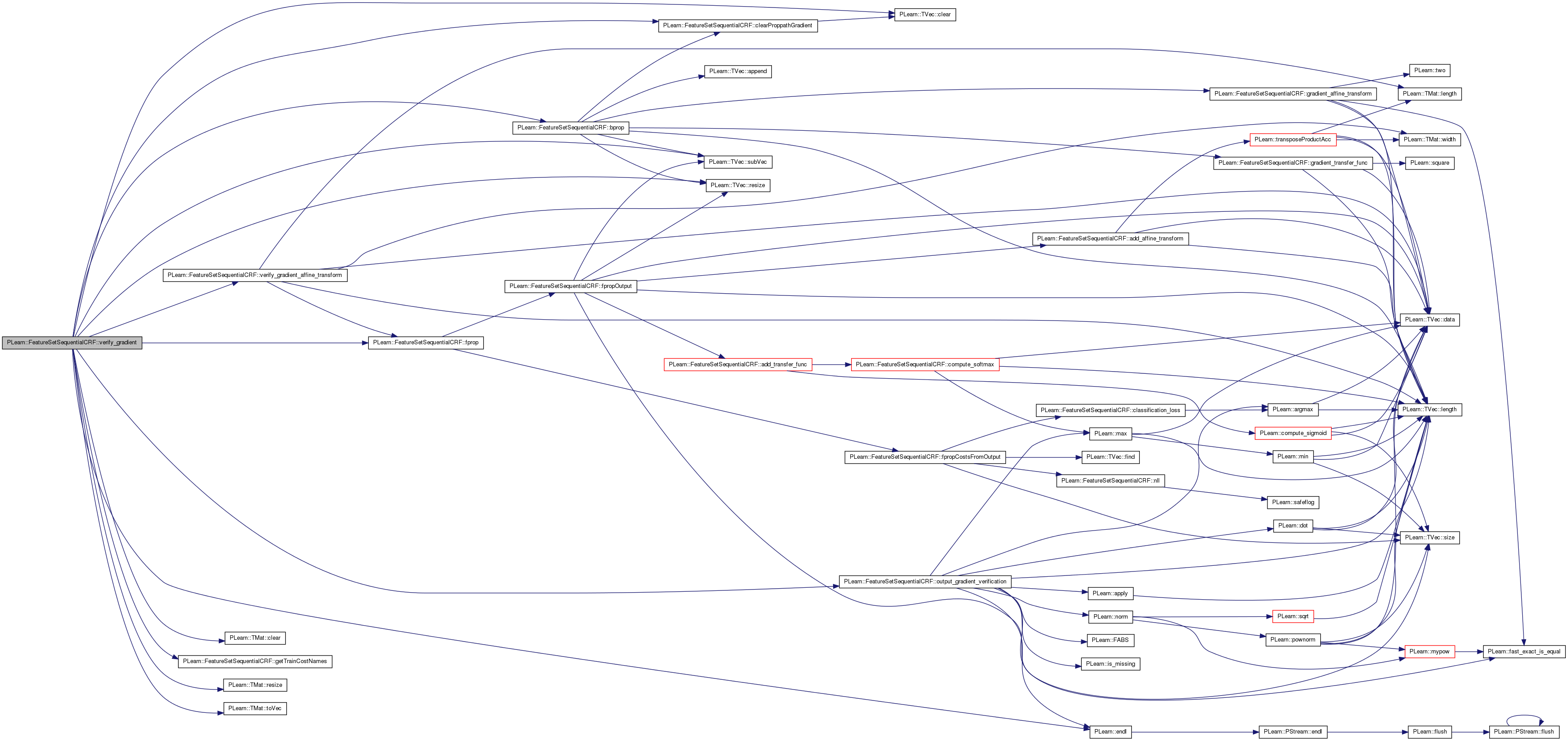
| void PLearn::FeatureSetSequentialCRF::verify_gradient_affine_transform | ( | Vec | global_input, |
| Vec & | global_output, | ||
| Vec & | global_targetv, | ||
| Vec & | global_costs, | ||
| real | sampleweight, | ||
| Vec | input, | ||
| Mat | weights, | ||
| Vec | bias, | ||
| Mat | est_gweights, | ||
| Vec | est_gbias, | ||
| bool | input_is_sparse, | ||
| bool | output_is_sparse, | ||
| real | step, | ||
| Vec | output_indices = Vec(0) |
||
| ) | const [protected] |
Verify gradient of affine_transform parameters.
Definition at line 2351 of file FeatureSetSequentialCRF.cc.
References PLearn::TVec< T >::data(), fprop(), i, j, PLearn::TMat< T >::length(), PLearn::TVec< T >::length(), ni, nj, pval1, pval2, pval3, and PLearn::TMat< T >::width().
Referenced by verify_gradient().
{
real *pval1, *pval2, *pval3;
int ni,nj;
real out1,out2;
// Bias
if(bias.length() != 0)
{
if(output_is_sparse)
{
pval1 = est_gbias.data();
pval2 = bias.data();
pval3 = output_indices.data();
ni = output_indices.length();
for(int i=0; i<ni; i++)
{
pval2[(int)*pval3] += step;
fprop(global_input, global_output, global_targetv, global_costs, sampleweight);
out1 = global_costs[0];
pval2[(int)*pval3] -= 2*step;
fprop(global_input, global_output, global_targetv, global_costs, sampleweight);
out2 = global_costs[0];
pval1[(int)*pval3] = (out1-out2)/(2*step);
pval2[(int)*pval3] += step;
pval3++;
}
}
else
{
pval1 = est_gbias.data();
pval2 = bias.data();
ni = bias.length();
for(int i=0; i<ni; i++)
{
*pval2 += step;
fprop(global_input, global_output, global_targetv, global_costs, sampleweight);
out1 = global_costs[0];
*pval2 -= 2*step;
fprop(global_input, global_output, global_targetv, global_costs, sampleweight);
out2 = global_costs[0];
*pval1 = (out1-out2)/(2*step);
*pval2 += step;
pval1++;
pval2++;
}
}
}
// Weights
if(!input_is_sparse && !output_is_sparse)
{
ni = weights.length();
nj = weights.width();
for(int i=0; i<ni; i++)
for(int j=0; j<nj; j++)
{
weights(i,j) += step;
fprop(global_input, global_output, global_targetv, global_costs, sampleweight);
out1 = global_costs[0];
weights(i,j) -= 2*step;
fprop(global_input, global_output, global_targetv, global_costs, sampleweight);
out2 = global_costs[0];
weights(i,j) += step;
est_gweights(i,j) = (out1-out2)/(2*step);
}
}
else if(!input_is_sparse && output_is_sparse)
{
ni = output_indices.length();
nj = input.length();
pval3 = output_indices.data();
for(int i=0; i<ni; i++)
{
for(int j=0; j<nj; j++)
{
weights(j,(int)*pval3) += step;
fprop(global_input, global_output, global_targetv, global_costs, sampleweight);
out1 = global_costs[0];
weights(j,(int)*pval3) -= 2*step;
fprop(global_input, global_output, global_targetv, global_costs, sampleweight);
out2 = global_costs[0];
weights(j,(int)*pval3) += step;
est_gweights(j,(int)*pval3) = (out1-out2)/(2*step);
// if(target_values.length() != 1 && input[j] != 0 && (out1-out2)/(2*step) == 0)
// {
// print_what_the_fuck();
// weights(j,(int)*pval3) += 1;
// fprop(global_input, global_output, global_targetv, global_costs, sampleweight);
// weights(j,(int)*pval3) -= 1;
// cout << "out1 - global_costs[0] =" << out1-global_costs[0] << endl;
// }
}
pval3++;
}
}
else if(input_is_sparse && !output_is_sparse)
{
ni = input.length();
nj = weights.width();
if(ni != 0 )
{
pval3 = input.data();
for(int i=0; i<ni; i++)
{
pval1 = est_gweights[(int)(*pval3)];
pval2 = weights[(int)(*pval3++)];
for(int j=0; j<nj;j++)
{
*pval2 += step;
fprop(global_input, global_output, global_targetv, global_costs, sampleweight);
out1 = global_costs[0];
*pval2 -= 2*step;
fprop(global_input, global_output, global_targetv, global_costs, sampleweight);
out2 = global_costs[0];
*pval1 = (out1-out2)/(2*step);
*pval2 += step;
pval1++;
pval2++;
}
}
}
}
else if(input_is_sparse && output_is_sparse)
{
// Weights
ni = input.length();
nj = output_indices.length();
if(ni != 0)
{
pval2 = input.data();
for(int i=0; i<ni; i++)
{
pval3 = output_indices.data();
for(int j=0; j<nj; j++)
{
weights((int)(*pval2),(int)*pval3) += step;
fprop(global_input, global_output, global_targetv, global_costs, sampleweight);
out1 = global_costs[0];
weights((int)(*pval2),(int)*pval3) -= 2*step;
fprop(global_input, global_output, global_targetv, global_costs, sampleweight);
out2 = global_costs[0];
est_gweights((int)(*pval2),(int)*pval3) = (out1-out2)/(2*step);
weights((int)(*pval2),(int)*pval3) += step;
pval3++;
}
pval2++;
}
}
}
}


Reimplemented from PLearn::PLearner.
Definition at line 294 of file FeatureSetSequentialCRF.h.
Bias of first hidden layer.
Definition at line 142 of file FeatureSetSequentialCRF.h.
Referenced by bprop(), declareOptions(), fpropOutput(), initializeParams(), makeDeepCopyFromShallowCopy(), update(), and verify_gradient().
Bias of second hidden layer.
Definition at line 150 of file FeatureSetSequentialCRF.h.
Referenced by bprop(), declareOptions(), fpropOutput(), initializeParams(), makeDeepCopyFromShallowCopy(), update(), and verify_gradient().
Number of samples to use to estimate gradient before an update.
0 means the whole training set (default: 1)
Definition at line 246 of file FeatureSetSequentialCRF.h.
Referenced by declareOptions().
Bias decay (default:0)
Definition at line 193 of file FeatureSetSequentialCRF.h.
Referenced by bprop(), declareOptions(), gradient_affine_transform(), and gradient_penalty().
Bias of output layer.
Definition at line 158 of file FeatureSetSequentialCRF.h.
Referenced by bprop(), declareOptions(), fpropOutput(), initializeParams(), makeDeepCopyFromShallowCopy(), update(), and verify_gradient().
Bias of output layer for distributed representation predictor.
Definition at line 177 of file FeatureSetSequentialCRF.h.
Referenced by bprop(), declareOptions(), fpropOutput(), initializeParams(), makeDeepCopyFromShallowCopy(), update(), and verify_gradient().
Cost functions.
Definition at line 239 of file FeatureSetSequentialCRF.h.
Referenced by bprop(), build_(), clearProppathGradient(), declareOptions(), fpropCostsFromOutput(), getTestCostNames(), getTrainCostNames(), and makeDeepCopyFromShallowCopy().
Decrease constant of gradietn descent.
Definition at line 243 of file FeatureSetSequentialCRF.h.
Referenced by declareOptions().
Direct input to output bias (empty, since no bias is used)
Definition at line 166 of file FeatureSetSequentialCRF.h.
Referenced by bprop(), declareOptions(), fpropOutput(), initializeParams(), makeDeepCopyFromShallowCopy(), update(), and verify_gradient().
If true then direct input to output weights will be added (if nhidden > 0)
Definition at line 229 of file FeatureSetSequentialCRF.h.
Referenced by bprop(), declareOptions(), fpropOutput(), initializeParams(), update(), and verify_gradient().
Weight decay for weights from input directly to output layer (default:0)
Definition at line 214 of file FeatureSetSequentialCRF.h.
Referenced by bprop(), and declareOptions().
Direct input to output weights.
Definition at line 162 of file FeatureSetSequentialCRF.h.
Referenced by bprop(), declareOptions(), fpropOutput(), initializeParams(), makeDeepCopyFromShallowCopy(), update(), and verify_gradient().
Dimensionality (number of components) of distributed representations If <= 0, than distributed representations will not be used.
Definition at line 254 of file FeatureSetSequentialCRF.h.
Referenced by bprop(), clearProppathGradient(), declareOptions(), fpropOutput(), initializeParams(), update(), and verify_gradient().
int* PLearn::FeatureSetSequentialCRF::f [mutable, private] |
Definition at line 85 of file FeatureSetSequentialCRF.h.
Referenced by fpropOutput().
Vec PLearn::FeatureSetSequentialCRF::feat_input [mutable, protected] |
Feature input;.
Definition at line 102 of file FeatureSetSequentialCRF.h.
Referenced by bprop(), fpropOutput(), initializeParams(), makeDeepCopyFromShallowCopy(), and verify_gradient().
FeatureSets to apply on input.
Definition at line 259 of file FeatureSetSequentialCRF.h.
Referenced by build_(), declareOptions(), fpropOutput(), initializeParams(), and makeDeepCopyFromShallowCopy().
TVec< TVec<int> > PLearn::FeatureSetSequentialCRF::feats [mutable, private] |
Features for each token.
Definition at line 74 of file FeatureSetSequentialCRF.h.
Referenced by bprop(), build_(), fpropOutput(), makeDeepCopyFromShallowCopy(), and verify_gradient().
Features seen in input since last update.
Definition at line 128 of file FeatureSetSequentialCRF.h.
Referenced by bprop(), makeDeepCopyFromShallowCopy(), and update().
If true then the output weights are not learned.
They are initialized to +1 or -1 randomly (default:false)
Definition at line 226 of file FeatureSetSequentialCRF.h.
Referenced by build_(), declareOptions(), and initializeParams().
real PLearn::FeatureSetSequentialCRF::grad [mutable, private] |
Definition at line 82 of file FeatureSetSequentialCRF.h.
Referenced by gradient_transfer_func().
Vec PLearn::FeatureSetSequentialCRF::gradient [mutable, private] |
Temporary computations variable, used in fprop() and bprop() Care must be taken when using these variables, since they are used by many different functions.
Definition at line 79 of file FeatureSetSequentialCRF.h.
Referenced by makeDeepCopyFromShallowCopy().
Gradient through second hidden layer activation.
Definition at line 120 of file FeatureSetSequentialCRF.h.
Referenced by bprop(), clearProppathGradient(), initializeParams(), and makeDeepCopyFromShallowCopy().
Gradient through first hidden layer activation.
Definition at line 114 of file FeatureSetSequentialCRF.h.
Referenced by bprop(), clearProppathGradient(), initializeParams(), and makeDeepCopyFromShallowCopy().
Gradient throught output layer activation.
Definition at line 124 of file FeatureSetSequentialCRF.h.
Referenced by bprop(), clearProppathGradient(), initializeParams(), and makeDeepCopyFromShallowCopy().
Gradient on bias of first hidden layer.
Definition at line 144 of file FeatureSetSequentialCRF.h.
Referenced by bprop(), initializeParams(), makeDeepCopyFromShallowCopy(), update(), and verify_gradient().
Gradient on bias of second hidden layer.
Definition at line 152 of file FeatureSetSequentialCRF.h.
Referenced by bprop(), initializeParams(), makeDeepCopyFromShallowCopy(), update(), and verify_gradient().
Gradient on bias of output layer.
Definition at line 160 of file FeatureSetSequentialCRF.h.
Referenced by bprop(), initializeParams(), makeDeepCopyFromShallowCopy(), update(), and verify_gradient().
Gradient on bias of output layer for distributed representation predictor.
Definition at line 180 of file FeatureSetSequentialCRF.h.
Referenced by bprop(), initializeParams(), makeDeepCopyFromShallowCopy(), update(), and verify_gradient().
Gradient on direct input to output bias (empty, since no bias is used)
Definition at line 168 of file FeatureSetSequentialCRF.h.
Referenced by bprop(), initializeParams(), makeDeepCopyFromShallowCopy(), update(), and verify_gradient().
Gradient on direct input to output weights.
Definition at line 164 of file FeatureSetSequentialCRF.h.
Referenced by bprop(), initializeParams(), makeDeepCopyFromShallowCopy(), update(), and verify_gradient().
Gradient on feature input (useless for now)
Definition at line 104 of file FeatureSetSequentialCRF.h.
Referenced by bprop(), and makeDeepCopyFromShallowCopy().
Gradient of second hidden layer.
Definition at line 118 of file FeatureSetSequentialCRF.h.
Referenced by bprop(), clearProppathGradient(), initializeParams(), and makeDeepCopyFromShallowCopy().
Vec PLearn::FeatureSetSequentialCRF::gradient_hiddenv [protected] |
Gradient of first hidden layer.
Definition at line 112 of file FeatureSetSequentialCRF.h.
Referenced by bprop(), clearProppathGradient(), initializeParams(), and makeDeepCopyFromShallowCopy().
Vec PLearn::FeatureSetSequentialCRF::gradient_last_layer [mutable, private] |
Gradient of last layer in back propagation.
Definition at line 72 of file FeatureSetSequentialCRF.h.
Referenced by bprop(), and makeDeepCopyFromShallowCopy().
Gradient for vector to NNet.
Definition at line 108 of file FeatureSetSequentialCRF.h.
Referenced by bprop(), clearProppathGradient(), initializeParams(), and makeDeepCopyFromShallowCopy().
Vec PLearn::FeatureSetSequentialCRF::gradient_outputv [protected] |
Gradient on output.
Definition at line 122 of file FeatureSetSequentialCRF.h.
Referenced by bprop(), clearProppathGradient(), initializeParams(), and makeDeepCopyFromShallowCopy().
Gradient on weights of first hidden layer.
Definition at line 140 of file FeatureSetSequentialCRF.h.
Referenced by bprop(), initializeParams(), makeDeepCopyFromShallowCopy(), update(), and verify_gradient().
gradient on weights of second hidden layer
Definition at line 148 of file FeatureSetSequentialCRF.h.
Referenced by bprop(), initializeParams(), makeDeepCopyFromShallowCopy(), update(), and verify_gradient().
Gradient on weights of output layer.
Definition at line 156 of file FeatureSetSequentialCRF.h.
Referenced by bprop(), initializeParams(), makeDeepCopyFromShallowCopy(), update(), and verify_gradient().
Gradient on weights of output layer for distributed representation predictor.
Definition at line 174 of file FeatureSetSequentialCRF.h.
Referenced by bprop(), initializeParams(), makeDeepCopyFromShallowCopy(), update(), and verify_gradient().
Vec PLearn::FeatureSetSequentialCRF::hidden2v [protected] |
Second hidden layer value.
Definition at line 116 of file FeatureSetSequentialCRF.h.
Referenced by bprop(), fpropOutput(), initializeParams(), makeDeepCopyFromShallowCopy(), and verify_gradient().
Transfer function to use for hidden units (default:"tanh") tanh, sigmoid, softplus, softmax, etc...
Definition at line 237 of file FeatureSetSequentialCRF.h.
Referenced by add_transfer_func(), declareOptions(), and gradient_transfer_func().
Vec PLearn::FeatureSetSequentialCRF::hiddenv [protected] |
First hidden layer value.
Definition at line 110 of file FeatureSetSequentialCRF.h.
Referenced by bprop(), fpropOutput(), initializeParams(), makeDeepCopyFromShallowCopy(), and verify_gradient().
int PLearn::FeatureSetSequentialCRF::id [mutable, private] |
Definition at line 84 of file FeatureSetSequentialCRF.h.
int PLearn::FeatureSetSequentialCRF::ifeats [mutable, private] |
Definition at line 84 of file FeatureSetSequentialCRF.h.
Referenced by bprop(), fpropOutput(), and verify_gradient().
Method of initialization for neural network's weights.
Definition at line 251 of file FeatureSetSequentialCRF.h.
Referenced by declareOptions(), and fillWeights().
Vec PLearn::FeatureSetSequentialCRF::last_layer [mutable, private] |
Last layer of network (pointer to either nnet_input, vnhidden or vnhidden2)
Definition at line 70 of file FeatureSetSequentialCRF.h.
Referenced by fpropOutput(), makeDeepCopyFromShallowCopy(), and verify_gradient().
Bias decay for weights from input layer to first hidden layer (default:0)
Definition at line 199 of file FeatureSetSequentialCRF.h.
Referenced by bprop(), and declareOptions().
Weight decay for weights from input layer to first hidden layer (default:0)
Definition at line 196 of file FeatureSetSequentialCRF.h.
Referenced by bprop(), and declareOptions().
Bias decay for weights from first hidden layer to second hidden layer (default:0)
Definition at line 205 of file FeatureSetSequentialCRF.h.
Referenced by bprop(), and declareOptions().
Weight decay for weights from first hidden layer to second hidden layer (default:0)
Definition at line 202 of file FeatureSetSequentialCRF.h.
Referenced by bprop(), and declareOptions().
Margin requirement, used only with the margin_perceptron_cost cost function (default:1)
Definition at line 223 of file FeatureSetSequentialCRF.h.
int PLearn::FeatureSetSequentialCRF::n_feat_sets [protected] |
Number of feature sets.
Definition at line 94 of file FeatureSetSequentialCRF.h.
Referenced by bprop(), build_(), fpropOutput(), initializeParams(), and verify_gradient().
int PLearn::FeatureSetSequentialCRF::nfeats [mutable, private] |
Definition at line 84 of file FeatureSetSequentialCRF.h.
Referenced by bprop(), fpropOutput(), and verify_gradient().
Number of hidden nunits in first hidden layer (default:0)
Definition at line 187 of file FeatureSetSequentialCRF.h.
Referenced by bprop(), clearProppathGradient(), declareOptions(), fpropOutput(), initializeParams(), update(), and verify_gradient().
Number of hidden units in second hidden layer (default:0)
Definition at line 189 of file FeatureSetSequentialCRF.h.
Referenced by bprop(), clearProppathGradient(), declareOptions(), fpropOutput(), initializeParams(), update(), and verify_gradient().
int PLearn::FeatureSetSequentialCRF::ni [mutable, private] |
Definition at line 84 of file FeatureSetSequentialCRF.h.
Referenced by add_affine_transform(), fpropOutput(), gradient_affine_transform(), gradient_penalty(), gradient_transfer_func(), update_affine_transform(), and verify_gradient_affine_transform().
int PLearn::FeatureSetSequentialCRF::nj [mutable, private] |
Definition at line 84 of file FeatureSetSequentialCRF.h.
Referenced by add_affine_transform(), fpropOutput(), gradient_affine_transform(), gradient_penalty(), update_affine_transform(), and verify_gradient_affine_transform().
int PLearn::FeatureSetSequentialCRF::nk [mutable, private] |
Definition at line 84 of file FeatureSetSequentialCRF.h.
Referenced by gradient_transfer_func().
Vec PLearn::FeatureSetSequentialCRF::nnet_input [protected] |
Input vector to NNet (after mapping into distributed representations)
Definition at line 106 of file FeatureSetSequentialCRF.h.
Referenced by bprop(), fpropOutput(), initializeParams(), makeDeepCopyFromShallowCopy(), and verify_gradient().
int PLearn::FeatureSetSequentialCRF::offset [mutable, private] |
Definition at line 83 of file FeatureSetSequentialCRF.h.
Referenced by fpropOutput().
Vec PLearn::FeatureSetSequentialCRF::output_comp [mutable, private] |
Vector for output computations.
Definition at line 65 of file FeatureSetSequentialCRF.h.
Referenced by build_(), computeOutput(), computeOutputAndCosts(), makeDeepCopyFromShallowCopy(), and verify_gradient().
Bias decay for weights from last hidden layer to output layer (default:0)
Definition at line 211 of file FeatureSetSequentialCRF.h.
Referenced by bprop(), and declareOptions().
Bias decay for weights from last hidden layer to output layer of distributed representation predictor (default:0)
Definition at line 220 of file FeatureSetSequentialCRF.h.
Referenced by bprop(), and declareOptions().
Weight decay for weights from last hidden layer to output layer of distributed representation predictor (default:0)
Definition at line 217 of file FeatureSetSequentialCRF.h.
Referenced by bprop(), and declareOptions().
Weight decay for weights from last hidden layer to output layer (default:0)
Definition at line 208 of file FeatureSetSequentialCRF.h.
Referenced by bprop(), and declareOptions().
Transfer function to use for ouput layer (default:"")
Definition at line 234 of file FeatureSetSequentialCRF.h.
Referenced by bprop(), declareOptions(), and fpropOutput().
Penalty to use on the weights (for weight and bias decay) (default:"L2_square")
Definition at line 232 of file FeatureSetSequentialCRF.h.
Referenced by build_(), declareOptions(), gradient_affine_transform(), and gradient_penalty().
Indication that the set of possible targets vary from one input vector to another.
Definition at line 257 of file FeatureSetSequentialCRF.h.
Referenced by bprop(), computeOutput(), computeOutputAndCosts(), declareOptions(), fpropCostsFromOutput(), fpropOutput(), update(), and verify_gradient().
real* PLearn::FeatureSetSequentialCRF::pval1 [mutable, private] |
Definition at line 81 of file FeatureSetSequentialCRF.h.
Referenced by add_affine_transform(), gradient_affine_transform(), gradient_penalty(), gradient_transfer_func(), update_affine_transform(), and verify_gradient_affine_transform().
real * PLearn::FeatureSetSequentialCRF::pval2 [mutable, private] |
Definition at line 81 of file FeatureSetSequentialCRF.h.
Referenced by add_affine_transform(), gradient_affine_transform(), gradient_penalty(), gradient_transfer_func(), update_affine_transform(), and verify_gradient_affine_transform().
real * PLearn::FeatureSetSequentialCRF::pval3 [mutable, private] |
Definition at line 81 of file FeatureSetSequentialCRF.h.
Referenced by add_affine_transform(), gradient_affine_transform(), gradient_penalty(), gradient_transfer_func(), update_affine_transform(), and verify_gradient_affine_transform().
real * PLearn::FeatureSetSequentialCRF::pval4 [mutable, private] |
Definition at line 81 of file FeatureSetSequentialCRF.h.
Referenced by gradient_affine_transform().
real * PLearn::FeatureSetSequentialCRF::pval5 [mutable, private] |
Definition at line 81 of file FeatureSetSequentialCRF.h.
Referenced by gradient_affine_transform().
int PLearn::FeatureSetSequentialCRF::reind_target [mutable, protected] |
Reindexed target.
Definition at line 100 of file FeatureSetSequentialCRF.h.
Referenced by bprop(), clearProppathGradient(), and fpropCostsFromOutput().
PP<PRandom> PLearn::FeatureSetSequentialCRF::rgen [protected] |
Random number generator for parameters initialization.
Definition at line 126 of file FeatureSetSequentialCRF.h.
Referenced by computeOutput(), computeOutputAndCosts(), fillWeights(), and initializeParams().
Vec PLearn::FeatureSetSequentialCRF::row [mutable, private] |
Row vector.
Definition at line 67 of file FeatureSetSequentialCRF.h.
Referenced by build_(), fpropOutput(), and makeDeepCopyFromShallowCopy().
Start learning rate of gradient descent.
Definition at line 241 of file FeatureSetSequentialCRF.h.
Referenced by declareOptions().
Indication that a trick to speedup stochastic gradient descent should be used.
Definition at line 249 of file FeatureSetSequentialCRF.h.
Referenced by bprop(), build_(), and declareOptions().
string PLearn::FeatureSetSequentialCRF::str [mutable, private] |
Definition at line 80 of file FeatureSetSequentialCRF.h.
Referenced by fpropOutput().
Vec PLearn::FeatureSetSequentialCRF::target_values [mutable, private] |
Vector of possible target values.
Definition at line 63 of file FeatureSetSequentialCRF.h.
Referenced by bprop(), computeOutput(), computeOutputAndCosts(), fpropCostsFromOutput(), fpropOutput(), makeDeepCopyFromShallowCopy(), and verify_gradient().
VMat PLearn::FeatureSetSequentialCRF::target_values_reference_set [mutable, protected] |
Possible target values mapping.
Definition at line 134 of file FeatureSetSequentialCRF.h.
Referenced by build_(), fpropOutput(), makeDeepCopyFromShallowCopy(), processDataSet(), test(), and use().
Possible target values seen since last update.
Definition at line 130 of file FeatureSetSequentialCRF.h.
Referenced by bprop(), makeDeepCopyFromShallowCopy(), and update().
Number of features per input token for which a distributed representation is computed.
Definition at line 98 of file FeatureSetSequentialCRF.h.
Referenced by initializeParams(), and verify_gradient().
Total output size.
Definition at line 90 of file FeatureSetSequentialCRF.h.
Referenced by build_(), initializeParams(), and verify_gradient().
int PLearn::FeatureSetSequentialCRF::total_updates [protected] |
Total updates so far;.
Definition at line 92 of file FeatureSetSequentialCRF.h.
Referenced by forget().
Indication that the input IDs should be used as the feature ID.
The ID/string mapping provided by the input VMatrix Dictionary objects is hence used. This implies that all VMatrices (even those at test time) that provide the input vectors should use the same Dictionary objects.
Definition at line 265 of file FeatureSetSequentialCRF.h.
real PLearn::FeatureSetSequentialCRF::val [mutable, private] |
Definition at line 82 of file FeatureSetSequentialCRF.h.
Referenced by gradient_affine_transform(), gradient_penalty(), and gradient_transfer_func().
real PLearn::FeatureSetSequentialCRF::val2 [mutable, private] |
Definition at line 82 of file FeatureSetSequentialCRF.h.
Referenced by gradient_affine_transform(), and gradient_penalty().
VMat PLearn::FeatureSetSequentialCRF::val_string_reference_set [mutable, protected] |
VMatrix used to get values to string mapping for input tokens.
Definition at line 132 of file FeatureSetSequentialCRF.h.
Referenced by batchComputeOutputAndConfidence(), build_(), fpropOutput(), makeDeepCopyFromShallowCopy(), processDataSet(), test(), and use().
Weights of first hidden layer.
Definition at line 138 of file FeatureSetSequentialCRF.h.
Referenced by bprop(), declareOptions(), fpropOutput(), initializeParams(), makeDeepCopyFromShallowCopy(), update(), and verify_gradient().
Weights of second hidden layer.
Definition at line 146 of file FeatureSetSequentialCRF.h.
Referenced by bprop(), declareOptions(), fpropOutput(), initializeParams(), makeDeepCopyFromShallowCopy(), update(), and verify_gradient().
Weight decay (default:0)
Definition at line 191 of file FeatureSetSequentialCRF.h.
Referenced by bprop(), declareOptions(), gradient_affine_transform(), and gradient_penalty().
Weights of output layer.
Definition at line 154 of file FeatureSetSequentialCRF.h.
Referenced by bprop(), declareOptions(), fpropOutput(), initializeParams(), makeDeepCopyFromShallowCopy(), update(), and verify_gradient().
Weights of output layer for distributed representation predictor.
Definition at line 171 of file FeatureSetSequentialCRF.h.
Referenced by bprop(), declareOptions(), fpropOutput(), initializeParams(), makeDeepCopyFromShallowCopy(), update(), and verify_gradient().
 1.7.4
1.7.4